Category
Engraving
5 entries in this category | view all categories
19th Century Game Theory
Posted October 2020 in Alternate Processes, Cameras, Engraving, Games, History of Photography, New Additions, Publishing
19th Century amateur photographers faced trials and tribulations in mastering their new found craft, put into the spotlight after photography itself became a growing mass medium with the marketing of Kodak’s #1 box camera in late 1888.
In 1889, taking advantage of this new large audience-by giving them a fun diversion- the Milton Bradley company of Springfield, Massachusetts produced what is believed to be the world’s first card game on photography, one they called “The Amateur Photographer”. So now, the agony and ecstasy experienced by those dedicated amateurs who owned more advanced cameras and maintained wet darkrooms while embracing art and science could be enjoyed by all. PhotoSeed recently acquired 24 cards of this game from the original set of 36.
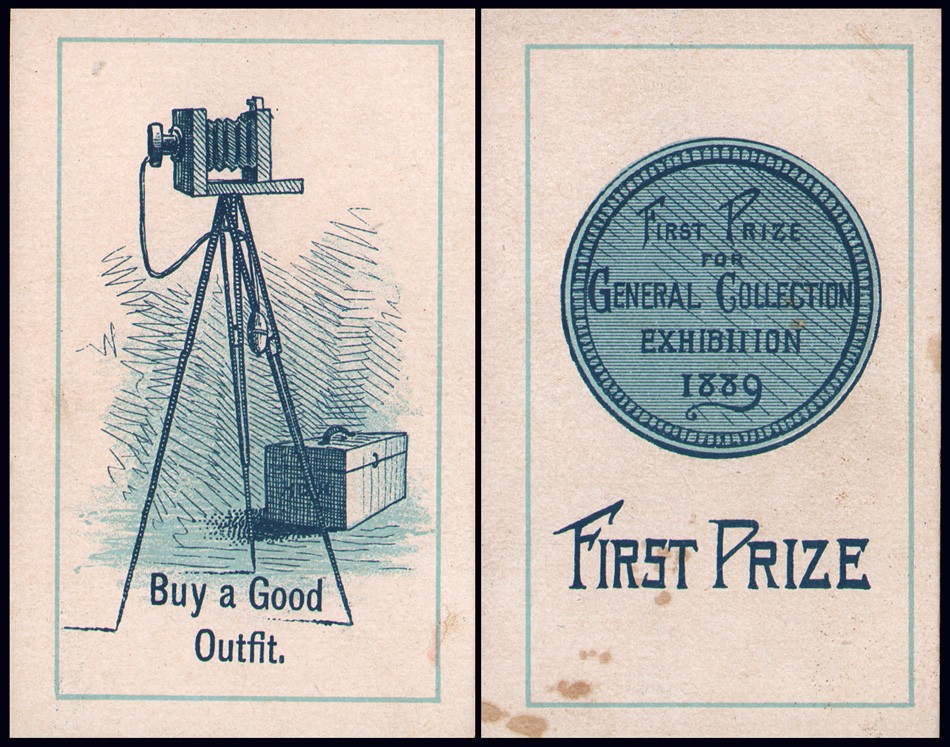 Left: “Buy a Good Outfit” : Right: “First Prize”. 1889. Individual coated-paper lithographic playing cards measuring 8.9 x 5.6 cm (3.5 x 2.25”). Milton Bradley Company, Springfield, MA. The cards making up the game “The Amateur Photographer” were illustrated to show “the triumphs and “hard luck” of an amateur photographer in a way that no member of the craft can fail to appreciate”. From: PhotoSeed Archive
Left: “Buy a Good Outfit” : Right: “First Prize”. 1889. Individual coated-paper lithographic playing cards measuring 8.9 x 5.6 cm (3.5 x 2.25”). Milton Bradley Company, Springfield, MA. The cards making up the game “The Amateur Photographer” were illustrated to show “the triumphs and “hard luck” of an amateur photographer in a way that no member of the craft can fail to appreciate”. From: PhotoSeed Archive
The directions for this Victorian card game can be seen printed below in a vintage advertisement for the 1889-90 Milton Bradley Company “Catalogue of Games, Sectional Pictures, Toys, Puzzles, Blocks and Novelties”.
For the most part up to the present day, physical card ⌘ and board games have never featured the character of the photographer, although video games beginning in the 1990’s have included many, including: “Polaroid Pete” (1992), “Pokémon Snap” (1999), “Dead Rising” (2006): excerpt: “gamers play photojournalist Frank West, who somehow got stuck in a shopping mall in Colorado during the zombie apocalypse. Frank has to fight his way out through hoardes of zombies and uncover the truth with his camera.” and “Spiderman 3” (2007).
Instead, popular culture has taken the lead, with the larger than life character of the photographer (for good and bad) celebrated in films taking hold in our collective imaginations. Some that come to mind by this writer include James Stewart’s character spying out his apartment window using a telephoto camera lens in Alfred Hitchcock’s masterful film “Rear Window”, (1954) and Peter Parker’s more recent alter-ego occupation sans Spiderman suit. Enjoy the following select game cards from this surviving set.
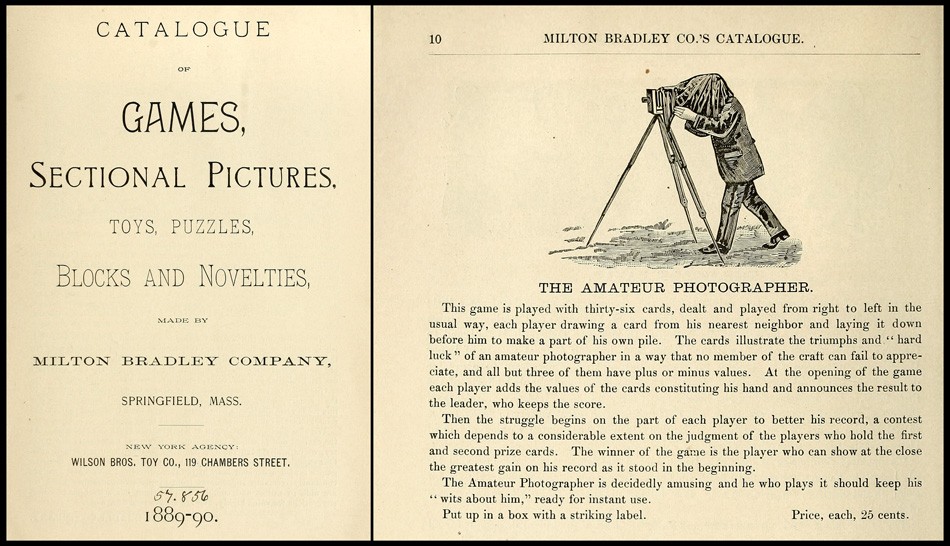 Left: Title Page from “Catalogue of Games, Sectional Pictures, Toys, Puzzles, Blocks and Novelties Made by Milton Bradley Company”. Right: Catalogue listing for card game “The Amateur Photographer” in same volume, 1889-90. (p. 10) Courtesy: Internet Archive
Left: Title Page from “Catalogue of Games, Sectional Pictures, Toys, Puzzles, Blocks and Novelties Made by Milton Bradley Company”. Right: Catalogue listing for card game “The Amateur Photographer” in same volume, 1889-90. (p. 10) Courtesy: Internet Archive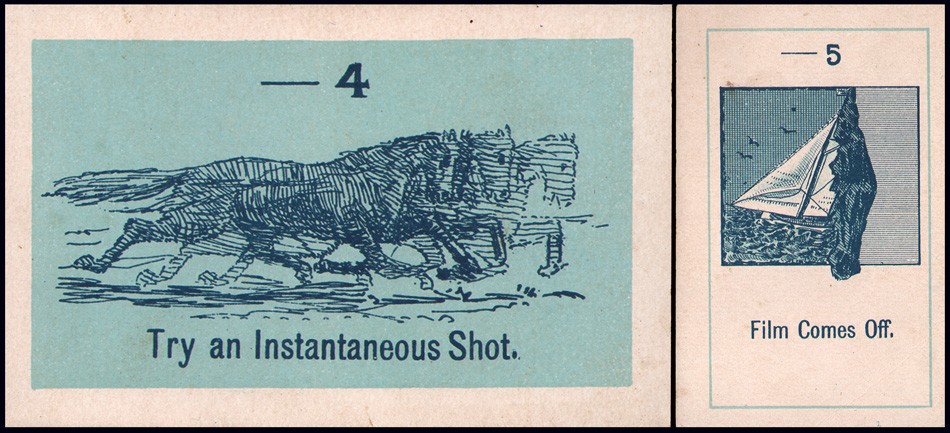 Left: “Try an Instantaneous Shot” : Right: “Film Comes Off”. 1889. Individual coated-paper lithographic playing cards measuring 8.9 x 5.6 cm (3.5 x 2.25”). Milton Bradley Company, Springfield, MA. The cards making up the game “The Amateur Photographer” were illustrated to show “the triumphs and “hard luck” of an amateur photographer in a way that no member of the craft can fail to appreciate”. These two negative value cards show two common problems: film emulsion sensitivity or improper camera settings on left card reveals the amateur’s error of not being able to “stop” the action of a race horse while the chemical darkroom problem of a peeling film emulsion (washing too vigorously perhaps?) ruining the masterwork of a sailboat photograph at right. From: PhotoSeed Archive
Left: “Try an Instantaneous Shot” : Right: “Film Comes Off”. 1889. Individual coated-paper lithographic playing cards measuring 8.9 x 5.6 cm (3.5 x 2.25”). Milton Bradley Company, Springfield, MA. The cards making up the game “The Amateur Photographer” were illustrated to show “the triumphs and “hard luck” of an amateur photographer in a way that no member of the craft can fail to appreciate”. These two negative value cards show two common problems: film emulsion sensitivity or improper camera settings on left card reveals the amateur’s error of not being able to “stop” the action of a race horse while the chemical darkroom problem of a peeling film emulsion (washing too vigorously perhaps?) ruining the masterwork of a sailboat photograph at right. From: PhotoSeed Archive
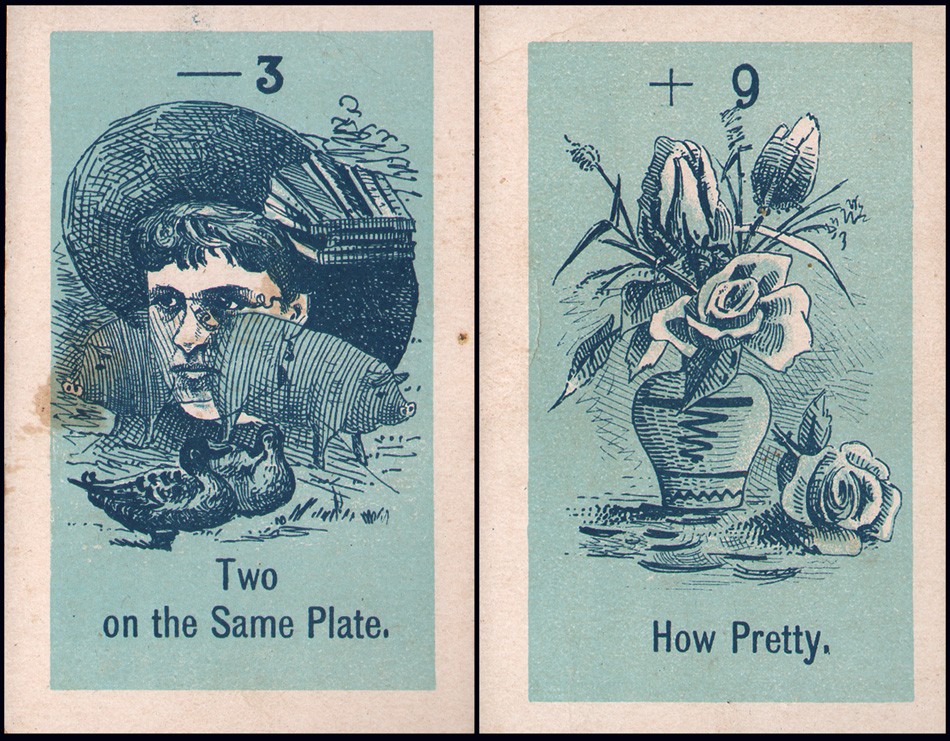 Left: “Two on the Same Plate” : Right: “How Pretty”. 1889. Individual coated-paper lithographic playing cards measuring 8.9 x 5.6 cm (3.5 x 2.25”). Milton Bradley Company, Springfield, MA. The cards making up the game “The Amateur Photographer” were illustrated to show “the triumphs and “hard luck” of an amateur photographer in a way that no member of the craft can fail to appreciate”. The negative value card at left shows the common problem of exposing the same photographic plate twice for two different scenes while at right, a positive value card shows a seemingly perfect picture of a bouquet of flowers. From: PhotoSeed Archive
Left: “Two on the Same Plate” : Right: “How Pretty”. 1889. Individual coated-paper lithographic playing cards measuring 8.9 x 5.6 cm (3.5 x 2.25”). Milton Bradley Company, Springfield, MA. The cards making up the game “The Amateur Photographer” were illustrated to show “the triumphs and “hard luck” of an amateur photographer in a way that no member of the craft can fail to appreciate”. The negative value card at left shows the common problem of exposing the same photographic plate twice for two different scenes while at right, a positive value card shows a seemingly perfect picture of a bouquet of flowers. From: PhotoSeed Archive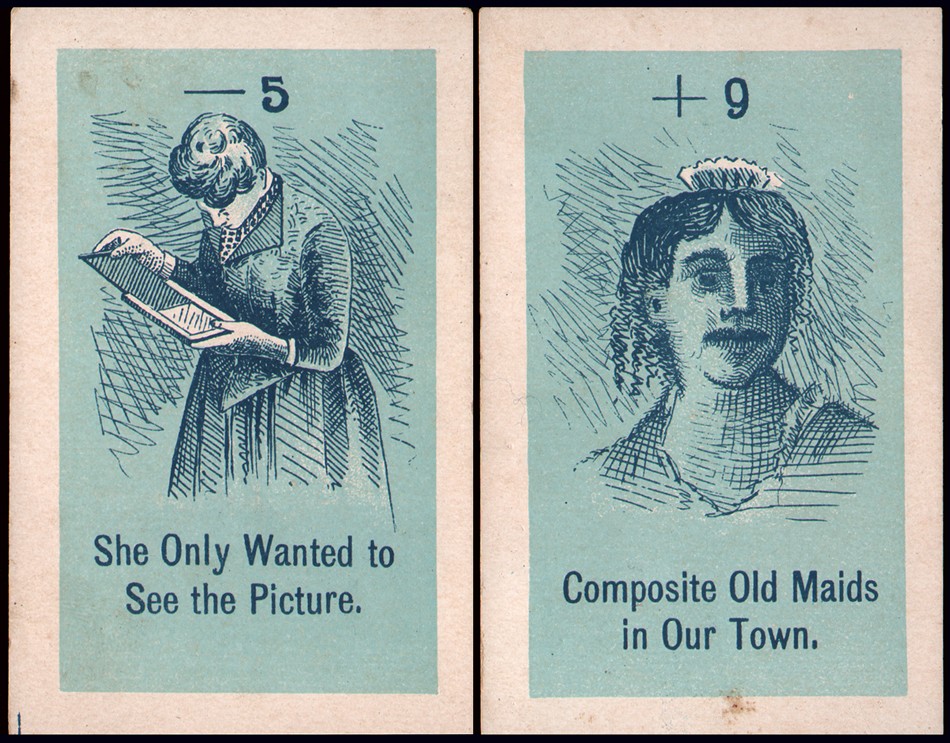 Left: “She Only Wanted to See the Picture” : Right: “Composite Old Maids in Our Town”. 1889. Individual coated-paper lithographic playing cards measuring 8.9 x 5.6 cm (3.5 x 2.25”). Milton Bradley Company, Springfield, MA. The cards making up the game “The Amateur Photographer” were illustrated to show “the triumphs and “hard luck” of an amateur photographer in a way that no member of the craft can fail to appreciate”. Gender sexism depicting the foibles of the female sex was alive and well when Amateur Photography first came into fashion- evidenced by the negative value card at left of a woman peeking at the results of an exposed photographic plate before the negative was properly fixed in the darkroom. Owing to the fact Photography was then a very expensive hobby and career opportunities for women in general were completely lacking, the majority of practitioners were men. But this would soon change, particularly after the dawn of the 20th Century, when Photography actually became one of the few occupations women were encouraged to pursue outside the home. At right, in a twist of this same gender sexism, a positive value card reveals itself in the form of this photographic portrait of an “old maid”, complete with mustache and tiara? or hair comb- with comparisons to later portraits of Queen Victoria by the card artist possibly being the so-called “humorous” intent. From: PhotoSeed Archive
Left: “She Only Wanted to See the Picture” : Right: “Composite Old Maids in Our Town”. 1889. Individual coated-paper lithographic playing cards measuring 8.9 x 5.6 cm (3.5 x 2.25”). Milton Bradley Company, Springfield, MA. The cards making up the game “The Amateur Photographer” were illustrated to show “the triumphs and “hard luck” of an amateur photographer in a way that no member of the craft can fail to appreciate”. Gender sexism depicting the foibles of the female sex was alive and well when Amateur Photography first came into fashion- evidenced by the negative value card at left of a woman peeking at the results of an exposed photographic plate before the negative was properly fixed in the darkroom. Owing to the fact Photography was then a very expensive hobby and career opportunities for women in general were completely lacking, the majority of practitioners were men. But this would soon change, particularly after the dawn of the 20th Century, when Photography actually became one of the few occupations women were encouraged to pursue outside the home. At right, in a twist of this same gender sexism, a positive value card reveals itself in the form of this photographic portrait of an “old maid”, complete with mustache and tiara? or hair comb- with comparisons to later portraits of Queen Victoria by the card artist possibly being the so-called “humorous” intent. From: PhotoSeed Archive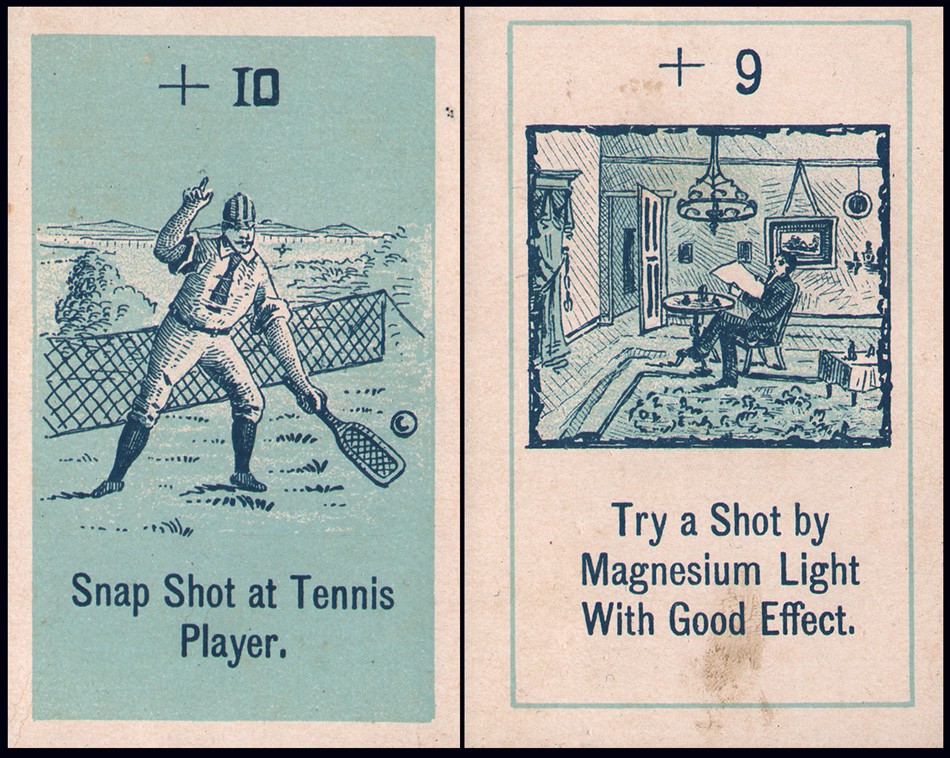 Left: “Snap Shot at Tennis Player” : Right: “Try a Shot by Magnesium Light With Good Effect”. 1889. Individual coated-paper lithographic playing cards measuring 8.9 x 5.6 cm (3.5 x 2.25”). Milton Bradley Company, Springfield, MA. The cards making up the game “The Amateur Photographer” were illustrated to show “the triumphs and “hard luck” of an amateur photographer in a way that no member of the craft can fail to appreciate”. These two high value cards reveal the very tricky technical goal of freezing sports action at left- something rarely attempted at the time- and at right, the undertaking of a so-called “flashlight” photograph. This was achieved on a photographic plate through the intense illumination given off during the ignition of flash powder made up of a mixture of nitrate and magnesium held off camera by the photographer. From: PhotoSeed Archive
Left: “Snap Shot at Tennis Player” : Right: “Try a Shot by Magnesium Light With Good Effect”. 1889. Individual coated-paper lithographic playing cards measuring 8.9 x 5.6 cm (3.5 x 2.25”). Milton Bradley Company, Springfield, MA. The cards making up the game “The Amateur Photographer” were illustrated to show “the triumphs and “hard luck” of an amateur photographer in a way that no member of the craft can fail to appreciate”. These two high value cards reveal the very tricky technical goal of freezing sports action at left- something rarely attempted at the time- and at right, the undertaking of a so-called “flashlight” photograph. This was achieved on a photographic plate through the intense illumination given off during the ignition of flash powder made up of a mixture of nitrate and magnesium held off camera by the photographer. From: PhotoSeed Archive
⌘ One exception found online by this website is the 2016 Japanese card game “Wind the Film!”, a half-frame camera photography themed card game for 2-4 players.
A Merry Christmas to All
Posted December 2015 in Engraving, Painters|Photographers, PhotoSeed, Publishing, Typography
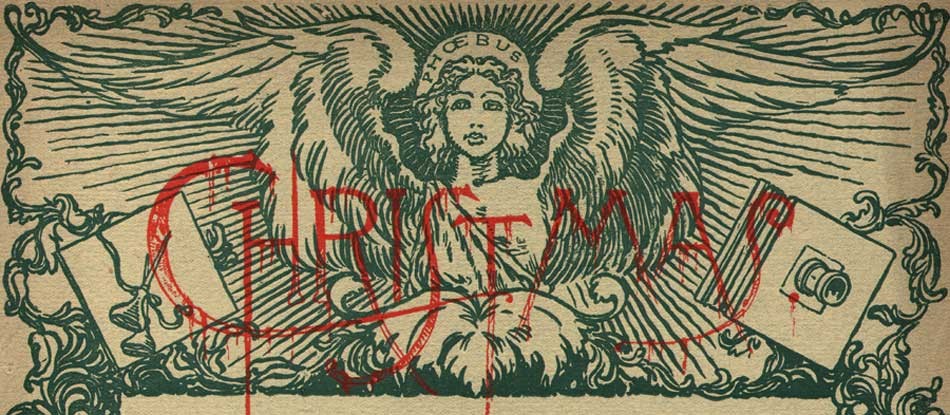 Detail: "Phoebus": by George Wharton Edwards: American 1859-1950: multiple-color woodcut used as part of cover illustration for periodical "Sun & Shade": New York: December, 1890: whole #28: N.Y. Photo-Gravure Co.: 32.1 x 25.3 cm | 35.3 x 28.0 cm: from: PhotoSeed Archive
Detail: "Phoebus": by George Wharton Edwards: American 1859-1950: multiple-color woodcut used as part of cover illustration for periodical "Sun & Shade": New York: December, 1890: whole #28: N.Y. Photo-Gravure Co.: 32.1 x 25.3 cm | 35.3 x 28.0 cm: from: PhotoSeed Archive
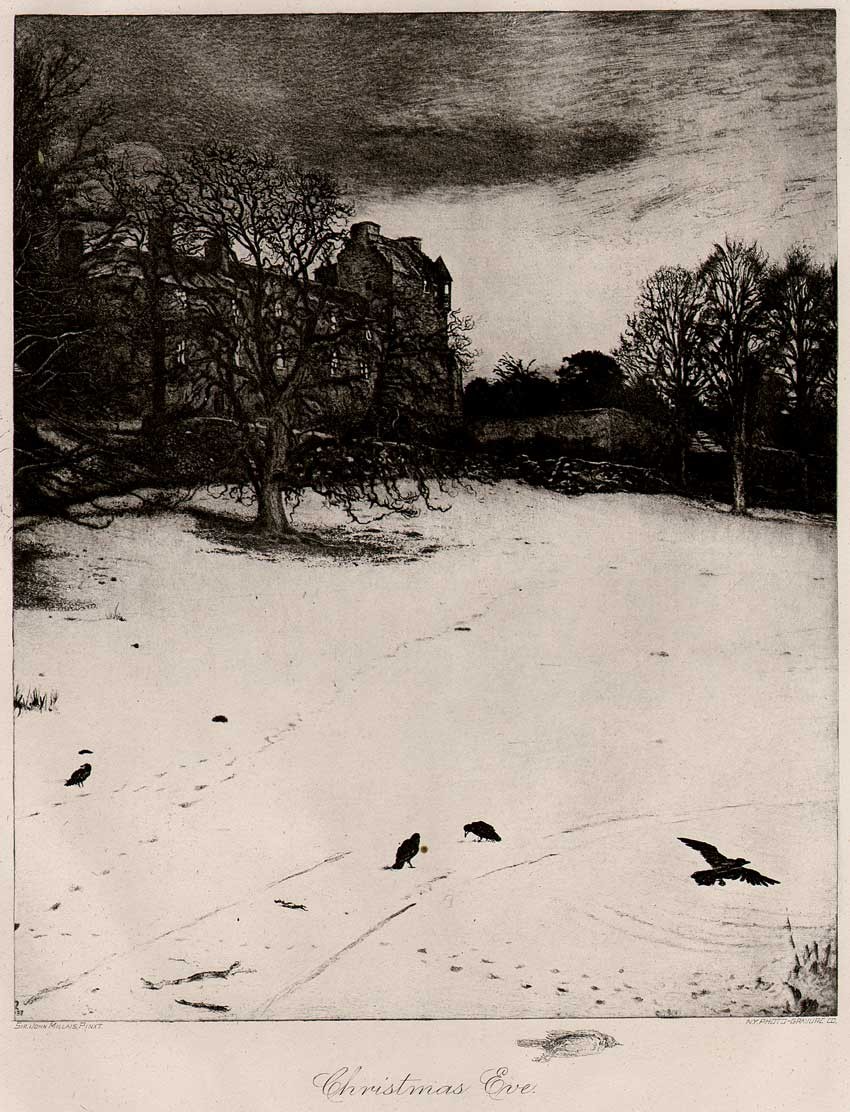 "Christmas Eve": by Sir John Everett Millais: English 1829-1896: photogravure published in periodical "Sun & Shade": New York: December, 1890: whole #28: N.Y. Photo-Gravure Co.: 19.2 x 15.7 cm | 34.9 x 27.2 cm: from: PhotoSeed Archive
"Christmas Eve": by Sir John Everett Millais: English 1829-1896: photogravure published in periodical "Sun & Shade": New York: December, 1890: whole #28: N.Y. Photo-Gravure Co.: 19.2 x 15.7 cm | 34.9 x 27.2 cm: from: PhotoSeed Archive
 Detail: "A Merry Christmas": Emilie V. Clarkson: American 1863-1946: photogravure published in periodical "Sun & Shade": New York: December, 1890: whole #28: N.Y. Photo-Gravure Co.: 20.1 x 14.5 cm | 34.9 x 27.2 cm: from: PhotoSeed Archive
Detail: "A Merry Christmas": Emilie V. Clarkson: American 1863-1946: photogravure published in periodical "Sun & Shade": New York: December, 1890: whole #28: N.Y. Photo-Gravure Co.: 20.1 x 14.5 cm | 34.9 x 27.2 cm: from: PhotoSeed Archive
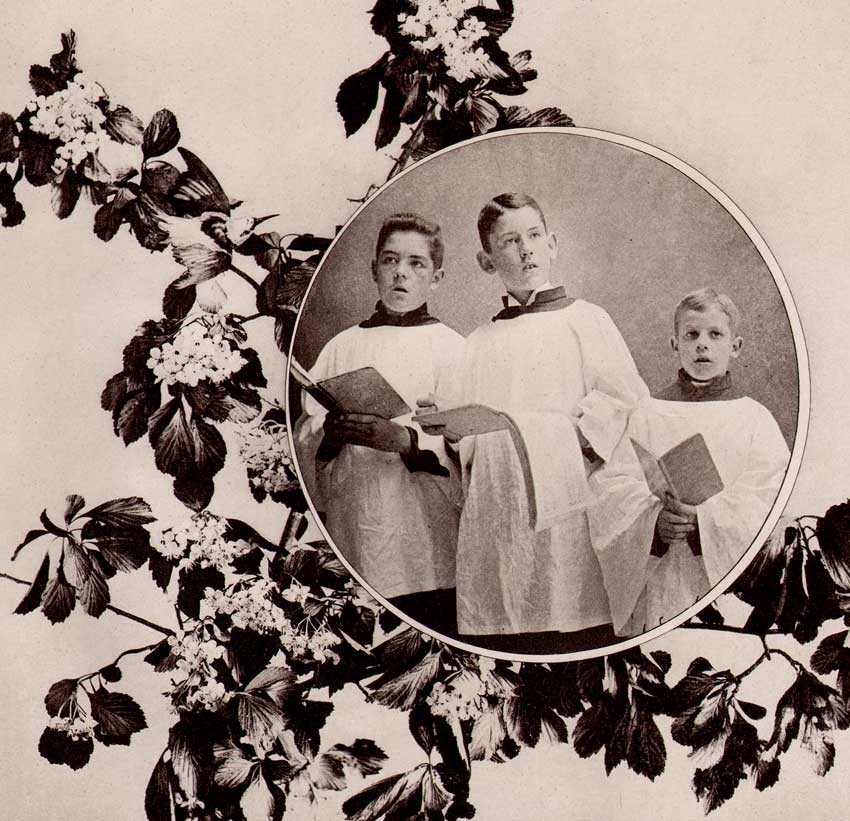 Detail: "We Praise Thee O Lord" ("Sang with many a change Christmas carols until morn.": Emilie V. Clarkson: American 1863-1946: photogravure published in periodical "Sun & Shade": New York: December, 1890: whole #28: N.Y. Photo-Gravure Co.: 20.0 x 15.5 cm | 34.9 x 27.2 cm: from: PhotoSeed Archive
Detail: "We Praise Thee O Lord" ("Sang with many a change Christmas carols until morn.": Emilie V. Clarkson: American 1863-1946: photogravure published in periodical "Sun & Shade": New York: December, 1890: whole #28: N.Y. Photo-Gravure Co.: 20.0 x 15.5 cm | 34.9 x 27.2 cm: from: PhotoSeed Archive
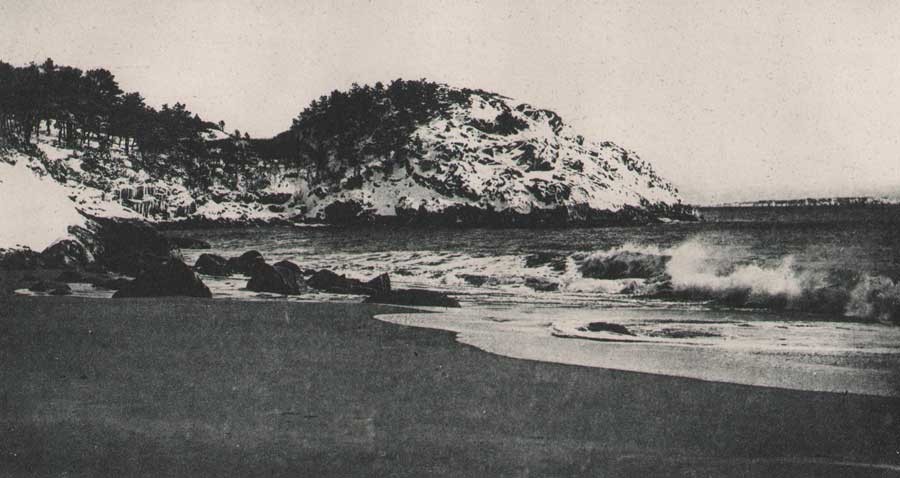 Detail: "Christmas Morning by the Sea" (alt: Winter's Touch on Land And Sea": Mrs. J.M. Appleton: American: photogravure published in periodical "Sun & Shade": New York: December, 1890: whole #28: N.Y. Photo-Gravure Co.: 10.5 x 16.1 cm | 34.9 x 27.2 cm: from: PhotoSeed Archive
Detail: "Christmas Morning by the Sea" (alt: Winter's Touch on Land And Sea": Mrs. J.M. Appleton: American: photogravure published in periodical "Sun & Shade": New York: December, 1890: whole #28: N.Y. Photo-Gravure Co.: 10.5 x 16.1 cm | 34.9 x 27.2 cm: from: PhotoSeed Archive
Needle in a Haystack
Posted March 2015 in Advertising, Childhood Photography, Engraving, Publishing, Significant Photographers, Typography
Surreal would be a good word for it. On the evening of Friday, November 4, 1904, the touring company of the Broadway flop Eben Holden made its way to a performance at a building called the Auditorium on S. 2nd Street in downtown Newark, Ohio.
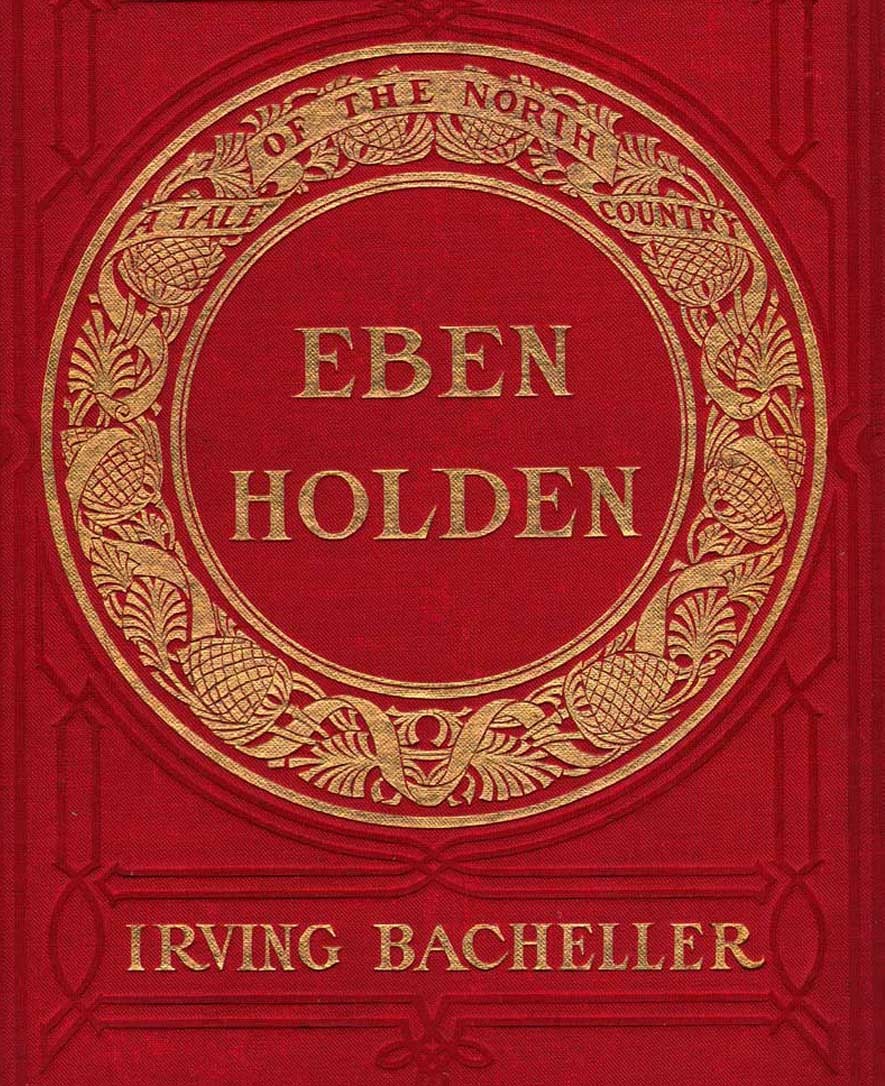 Detail: Cover for "Eben Holden: A Tale of The North Country": Edition de luxe by Irving Bacheller. Lothrop Publishing, Boston: 1903. Gilt-engraved decorative cloth with circular design featuring a design of a ribbon interlaced with pinecones and leaves: 21.0 x 14.2 cm: One of the best selling novels from the very beginning of the 20th Century, this edition features 12 photogravure plates by photographer Clarence Hudson White. from: PhotoSeed Archive
Detail: Cover for "Eben Holden: A Tale of The North Country": Edition de luxe by Irving Bacheller. Lothrop Publishing, Boston: 1903. Gilt-engraved decorative cloth with circular design featuring a design of a ribbon interlaced with pinecones and leaves: 21.0 x 14.2 cm: One of the best selling novels from the very beginning of the 20th Century, this edition features 12 photogravure plates by photographer Clarence Hudson White. from: PhotoSeed Archive
Most likely in attendance that night? Clarence Hudson White, (1871-1925) the world-renowned pictorialist photographer who was a recent founding member of the American Photo-Secession and current Newark resident. Only two years earlier, he had taken a series of photographs using his Newark neighbors as models for a special edition of Eben Holden that had been made into this very play.
Written by American journalist and author Irving Bacheller, (1859-1950) the story is a classic rags to riches tale that captivated the masses in the new American century when first published in July of 1900, eventually selling over 1 million copies. The setting at the beginning of the novel is the “North Country” of Northern Vermont , the Adirondack’s and St. Lawrence River Valley of the 1840’s and 1850’s. It tells the coming of age story of William Brower, orphaned at the age of six after his parents and older brother accidentally drowned as well as his relationship with Eben Holden, a farm hand who rescued “Willy” from the cruel fate of an orphanage
But this post is part collecting story, a kind of hunt for treasure, or “spondoolix” as “Uncle Eb” would say in one chapter-his country ways and lack of education brought into sharper focus for the reader by Bacheller’s liberal usage of Holden’s spoken dialect.
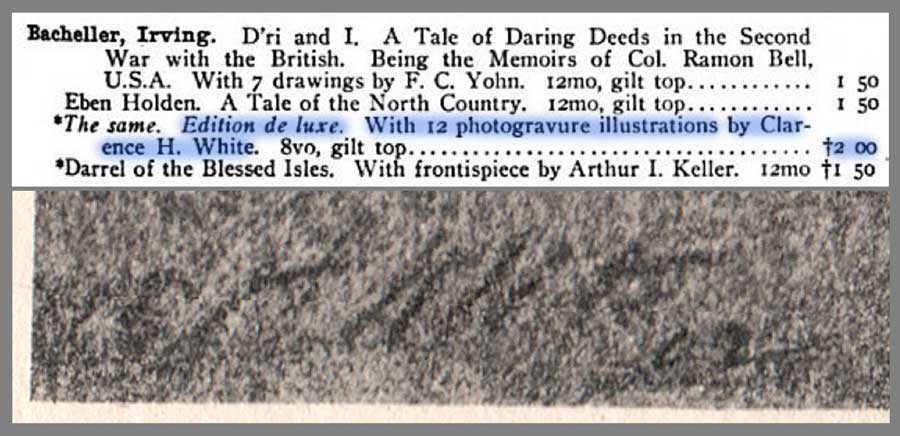 Detail: Top: listing for works by American author Irving Bacheller showing Edition de luxe of Eben Holden highlighted in blue: from: Illustrated Catalogue of Books Standard and Holiday 1903-1904: Chicago: A.C. McClurg and Company: 1903: p. 217 (the † denotes it is a work of fiction, published since November 1, 1902, under the rules of the American Publishers' Association. (from: Hathi Trust)Bottom: close-up detail showing autograph for CH White 02 at bottom left corner of representative photogravure plate from the Edition de luxe: from: PhotoSeed Archive
Detail: Top: listing for works by American author Irving Bacheller showing Edition de luxe of Eben Holden highlighted in blue: from: Illustrated Catalogue of Books Standard and Holiday 1903-1904: Chicago: A.C. McClurg and Company: 1903: p. 217 (the † denotes it is a work of fiction, published since November 1, 1902, under the rules of the American Publishers' Association. (from: Hathi Trust)Bottom: close-up detail showing autograph for CH White 02 at bottom left corner of representative photogravure plate from the Edition de luxe: from: PhotoSeed Archive
The Hunt is on
I consider myself a newbie collector, but one of the first things I put on my list 15 years ago when I first started out was one particular impression of Eben Holden rumored to have been illustrated by hand-pulled photogravures by White, the aforementioned famous photographer.
My curiosity had been piqued after seeing the volume listed in several bibliographies, typically stating the 1900 date. One such entry in author Christian A. Peterson’s Annotated Bibliography on Pictorial Photography did give me hope the work existed, even though finding one in the internet age would prove to be quite the challenge:
The Museum of Modern Art, New York, holds what is probably a unique copy of this book, comprised of the Lothrop text pages bound in leather, with an inscription by White and ten photogravure illustrations by him, including the portrait of Holden. (1.)
Because the novel had been such a success a century earlier, the reality of upwards of 500 vintage copies for sale on the web at any one time was daunting. My course of action however was simple, and eventually effective: send out a mass number of emails to every bookseller in the U.S. listing a copy from a suspect 1901 edition I had honed in on inquiring if it contained any photographic illustrations.
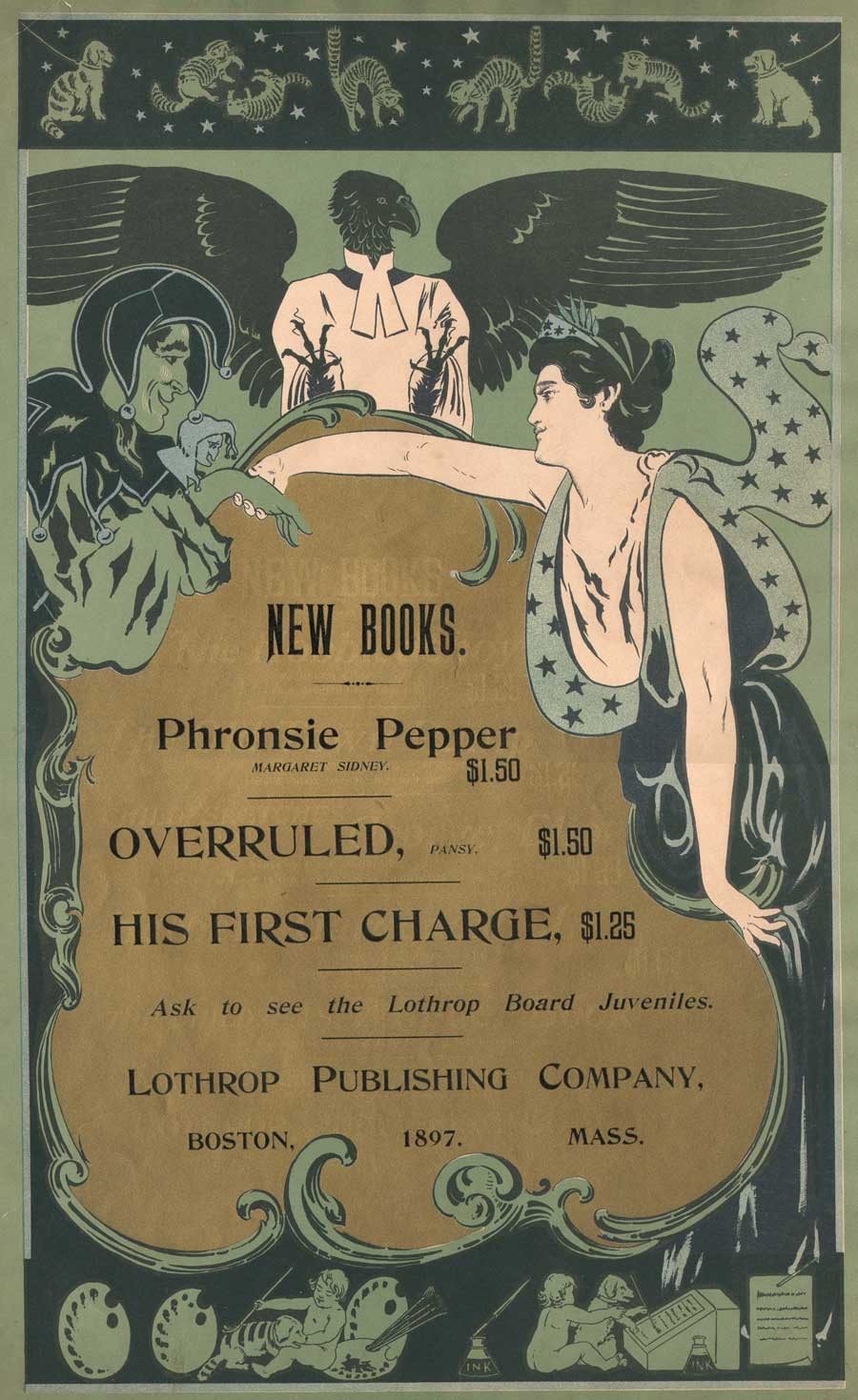 Broadside advertising poster for Lothrop Publishing Company of Boston: 1897: artist: William Schumacher: American: (1870-1931) multiple-color lithograph printed on wove paper: 52.7 x 34.0 cm. Speaking of the beginnings of Eben Holden in the year 1897, author Irving Bacheller said "had unsuccessfully offered the first 'Eben Holden' as it then stood to two juvenile publications; but as I happened to be just starting off on a vacation at that time, I determined myself to see the Boston firm, which was the Lothrop Publishing Company. I met the editor, Mr. Brooks, at the Parker House, and told him the story as I had written it. He immediately saw the possibilities in it and declared I had a big thing if I could carry it out as it should be." (excerpt: "The Critic": Oct. 1904) vintage broadside (trimmed) from: PhotoSeed Archive
Broadside advertising poster for Lothrop Publishing Company of Boston: 1897: artist: William Schumacher: American: (1870-1931) multiple-color lithograph printed on wove paper: 52.7 x 34.0 cm. Speaking of the beginnings of Eben Holden in the year 1897, author Irving Bacheller said "had unsuccessfully offered the first 'Eben Holden' as it then stood to two juvenile publications; but as I happened to be just starting off on a vacation at that time, I determined myself to see the Boston firm, which was the Lothrop Publishing Company. I met the editor, Mr. Brooks, at the Parker House, and told him the story as I had written it. He immediately saw the possibilities in it and declared I had a big thing if I could carry it out as it should be." (excerpt: "The Critic": Oct. 1904) vintage broadside (trimmed) from: PhotoSeed Archive
And so eventually luck prevailed. In 2007, a bookseller in Idaho finally said yes, and a bucket item was now on my library shelf. But that was not the end of it, as Alice would say, things got Curiouser and Curiouser! Because collectors never stop looking, I soon stumbled upon a CT bookseller who knew exactly the significance of the White-illustrated impression, with an astronomical asking price. An excerpt from his description of the work stated:
Elusive and highly desirable work, absent from almost all museum and library collections devoted to photography, and one of only a very few photographically illustrated books produced by a leading member of the Stieglitz circle at the height of the Photo-Secession. (2.)
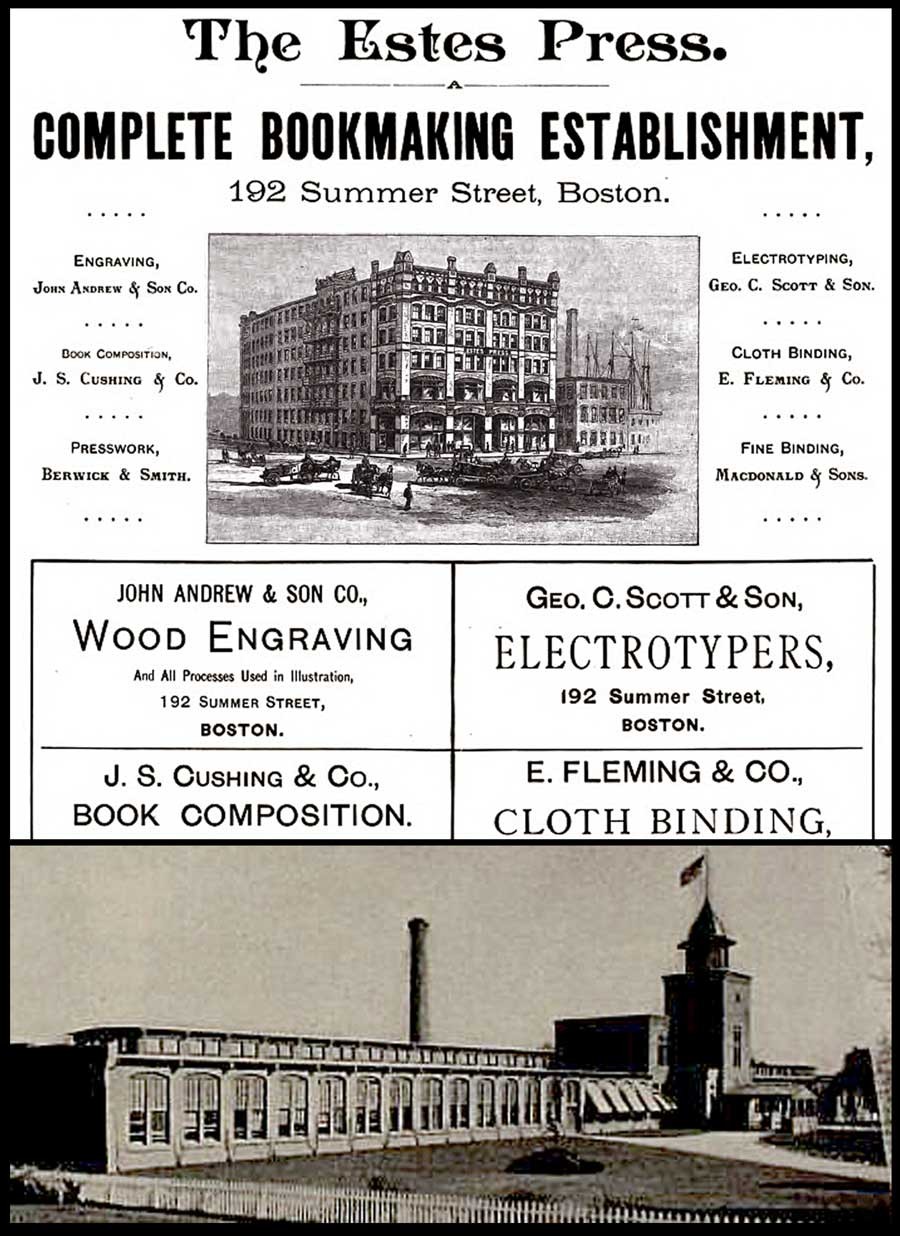 Top: detail: 1891 advertisement for The Estes Press (Dana Estes & Company) from "The American Bookmaker". The woodcut shows the brand new Estes Press Buildings located at 192 Summer St. in Boston first occupied around 1890. The firm housed many different companies involved in the bookmaking process, including: "The celebrated engravers, John Andrew & Son have their studios in the upper story…"; J.S. Cushing & Co., (book composition) Berwick & Smith, (presswork) and E. Fleming & Co. (binding). These last three firms left Estes in 1894 and became part of the Norwood Press. (from: Hathi Trust) Bottom: detail: exterior photograph of Norwood Press from the 1897 volume "Boston Massachusetts" by George W. Englehardt. The original caption noted the firm was located "Fourteen Miles from Boston, on the New England Road" and "as a whole employing nearly three hundred hands." This is where the Eben Holden Edition de luxe was printed. (from: Hathi Trust)
Top: detail: 1891 advertisement for The Estes Press (Dana Estes & Company) from "The American Bookmaker". The woodcut shows the brand new Estes Press Buildings located at 192 Summer St. in Boston first occupied around 1890. The firm housed many different companies involved in the bookmaking process, including: "The celebrated engravers, John Andrew & Son have their studios in the upper story…"; J.S. Cushing & Co., (book composition) Berwick & Smith, (presswork) and E. Fleming & Co. (binding). These last three firms left Estes in 1894 and became part of the Norwood Press. (from: Hathi Trust) Bottom: detail: exterior photograph of Norwood Press from the 1897 volume "Boston Massachusetts" by George W. Englehardt. The original caption noted the firm was located "Fourteen Miles from Boston, on the New England Road" and "as a whole employing nearly three hundred hands." This is where the Eben Holden Edition de luxe was printed. (from: Hathi Trust)
And so I sucked it in and didn’t purchase the second copy, which he told me he had originally purchased in Marlborough, NH. Eventually he sold it to a European collection, but I’ve since visited him several times and made a few purchases over the years, something I highly recommend rather than doing everything through e-commerce.
But then lighting struck again five years ago, when I purchased a second copy which had been personally inscribed by the author in 1911 to John A. Dix, then governor of New York state.
Curiouser? The first copy, fourth edition imprint stated Two Hundred and Sixty-fifth Thousand, March 12, 1901 and the second copy was for Two Hundred and Seventieth Thousand, September 18, 1903.
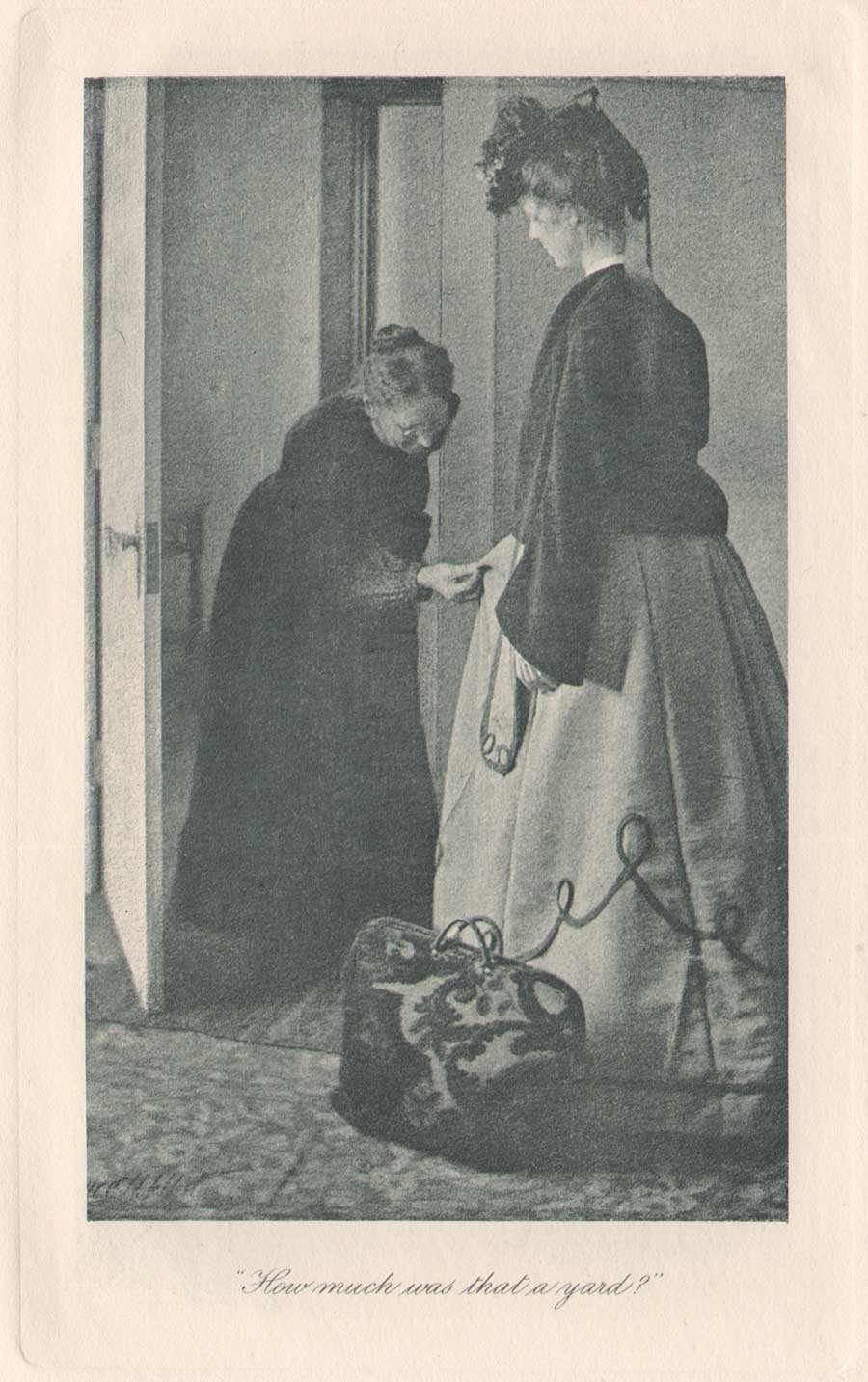 Detail: Clarence H. White: American: "How much was that a yard ?" Hand-pulled photogravure plate printed by John Andrew & Son (image: 12.2 x 7.5 cm | support: 20.0 x 14.0 cm ) from: Edition de luxe impression of Eben Holden: Lothrop Publishing, Boston: 1903. The Library of Congress states the model at right is Ann Fulton and the woman examining the dress is the photographer's mother Phoebe Billman White (1845-1920) : from: PhotoSeed Archive
Detail: Clarence H. White: American: "How much was that a yard ?" Hand-pulled photogravure plate printed by John Andrew & Son (image: 12.2 x 7.5 cm | support: 20.0 x 14.0 cm ) from: Edition de luxe impression of Eben Holden: Lothrop Publishing, Boston: 1903. The Library of Congress states the model at right is Ann Fulton and the woman examining the dress is the photographer's mother Phoebe Billman White (1845-1920) : from: PhotoSeed Archive
Knowing the book now existed in multiple impressions with the Clarence White photogravures was perplexing to me at first, but I’m certain the inclusion of the White photographs was intended by the publisher Lothrop for a more discriminating audience, so its assumed they had the monetary incentive to publish more than the one impression-even with the fickleness and extra work necessary to bind an edition with hand-pulled gravures.
To this end, my research in preparing this post discovered 1901 to be the year Clarence White was first commissioned by the Boston publisher to illustrate a new edition of Eben Holden. The intended publication date of very late 1902 was designed to coincide with the lucrative holiday sales season. Even with the move to e-books in our modern age, publishers earn good money issuing ornate and extra-illustrated editions during this time of year catering to the once a year book buyer and bibliophile alike.
Known as the Edition de luxe, this edition of Eben Holden with the White photogravures priced at $2.00 somehow managed to miss the late 1902 holiday sales season. The curious fact of the inclusion of the imprint for March 12, 1901 on the limitation page and White’s signature including the year 02 on many of the 12 plates in the published work was basic economics for publisher Lothrop-they simply used existing leaves, including the old limitation pages from current stock when it was eventually released for sale to bookstores in 1903.
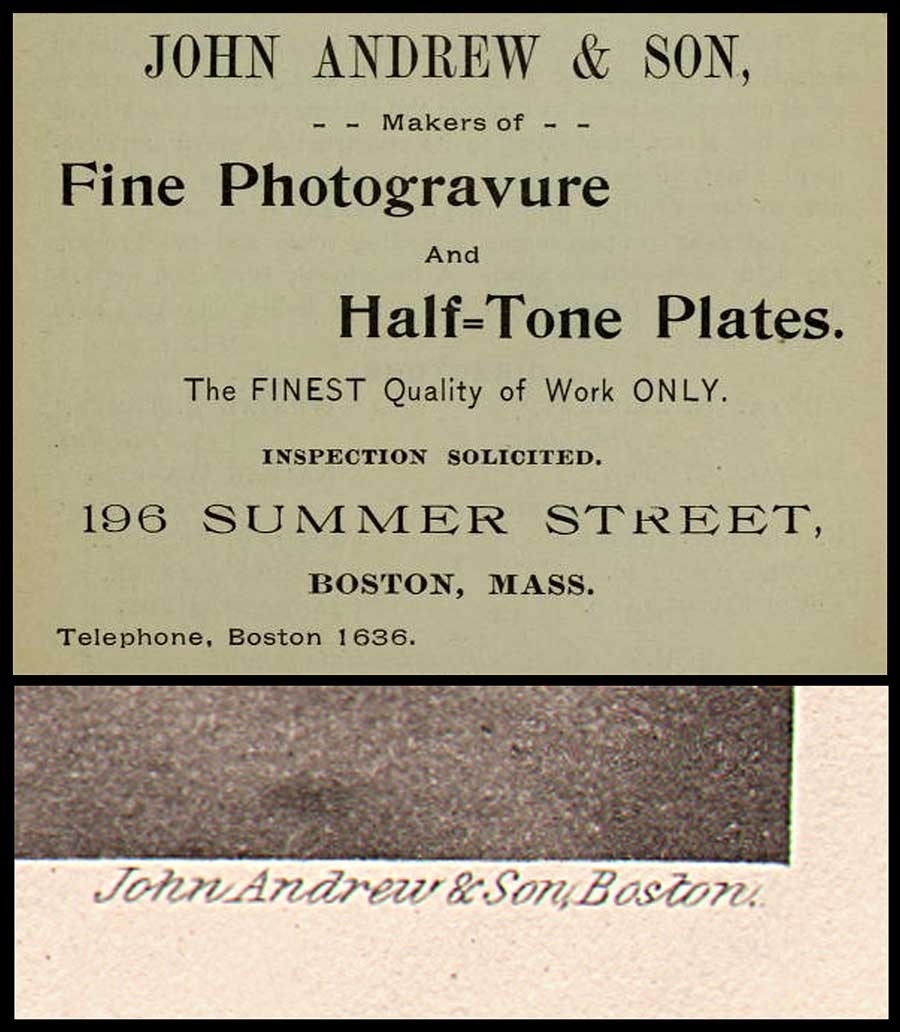 Top: detail: 1896: advertisement for John Andrew & Son from the "Boston Blue Book". (from: Hathi Trust) Bottom: detail: typical example of the firm's engraved credit appearing at lower right corner of image margin on plate recto from the 1903 Photographic Times-Bulletin. The John Andrew firm was established in Boston in 1852. from: PhotoSeed Archive
Top: detail: 1896: advertisement for John Andrew & Son from the "Boston Blue Book". (from: Hathi Trust) Bottom: detail: typical example of the firm's engraved credit appearing at lower right corner of image margin on plate recto from the 1903 Photographic Times-Bulletin. The John Andrew firm was established in Boston in 1852. from: PhotoSeed Archive
This was by no means unprecedented by Lothrop, or other large publishing houses of the era, as they would have set aside a certain number of unbound sheets from a best-selling work for limited impressions featuring artwork. The first illustrated edition of Eben Holden featured halftone photographs taken by Joseph Byron from the Broadway production of the same name hadn’t even debuted until Oct. 28 of 1901. This also used the March 12, 1901 imprint date. Known as the Dramatic Edition, it was described in the trade monthly The Bookseller:
”An illustrated edition of Eben Holden has been recently published called the Dramatic edition. It contains seven pictures of the play as it appeared in New York and a fine portrait of the author.” (3.)
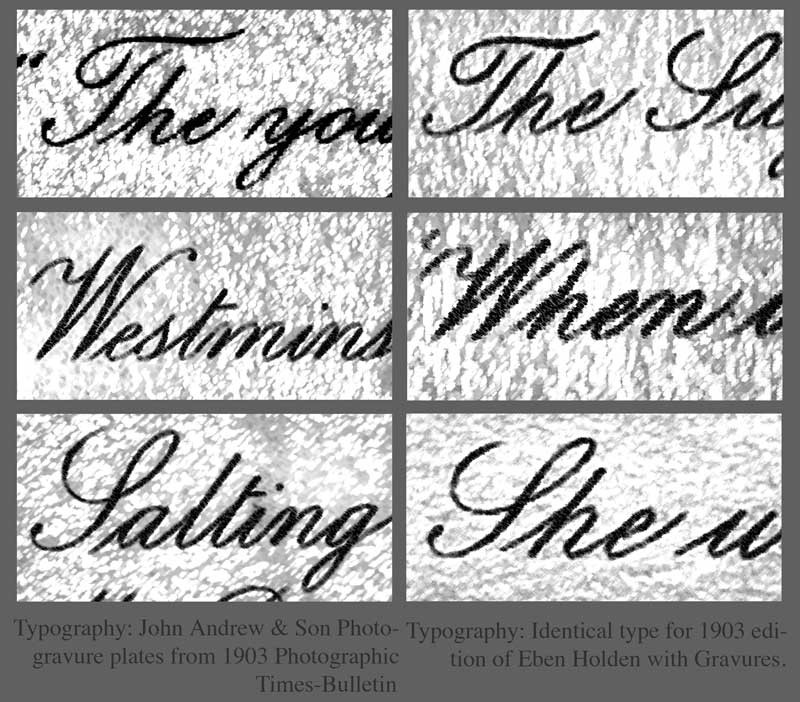 Details: with manipulations in PhotoShop to highlight typography: In order to show Boston's John Andrew & Son atelier printed the photogravure plates uncredited in the de luxe edition of Eben Holden, it is useful to analyze the script font typeface used for photographic plate titles. Column at left, top to bottom shows known examples from the Andrew atelier taken from the 1903 Photographic Times-Bulletin. Column at right shows plate titles from the Eben Holden volume. all from PhotoSeed Archive.
Details: with manipulations in PhotoShop to highlight typography: In order to show Boston's John Andrew & Son atelier printed the photogravure plates uncredited in the de luxe edition of Eben Holden, it is useful to analyze the script font typeface used for photographic plate titles. Column at left, top to bottom shows known examples from the Andrew atelier taken from the 1903 Photographic Times-Bulletin. Column at right shows plate titles from the Eben Holden volume. all from PhotoSeed Archive.
Published in 1903
Finally, with the eventual tenth imprint of the fourth edition stating Two Hundred and Seventieth Thousand, September 18, 1903, (6.) the makeup of the Edition de luxe was that of a small 8vo Octavo instead of the common edition, a 12mo Duodecimo. The inclusion of 12 fine, hand-pulled photogravure plates by White seen here is another matter altogether. For one, other than White’s autograph-appearing often (and faintly) in the lower left hand corner of each plate image as CH White 02, the Edition de luxe neglects to give him any printed credit for the photographs nor the atelier who printed them. This is very surprising for a special edition. Typically, there would at the very least be a separate illustrations page noting titles and page numbers at the front of a similar volume, but for whatever reason they were not included.
Stieglitz plays Go Between
With Eben Holden’s great success, the dramatization of the novel on the Broadway stage was logical for its day-especially since the Cinema was not an option because of the infancy of the medium. Lothrop’s piggy-backing of the work through this Dramatic edition, even by the “flop” standard of 49 performances, was but one way of keeping the work “fresh”- even a full year after initial publication. At some point late in 1901, a result perhaps of someone seeing the play on Broadway or believing White’s work would lend itself nicely to a series of photographic illustrations, the Boston publisher-perhaps through an association with Fred Holland Day (who lived in nearby Norwood where the Norwood Press printed books for Lothrop) or Alfred Stieglitz in New York-gave White the commission for its second illustrated edition of the novel.
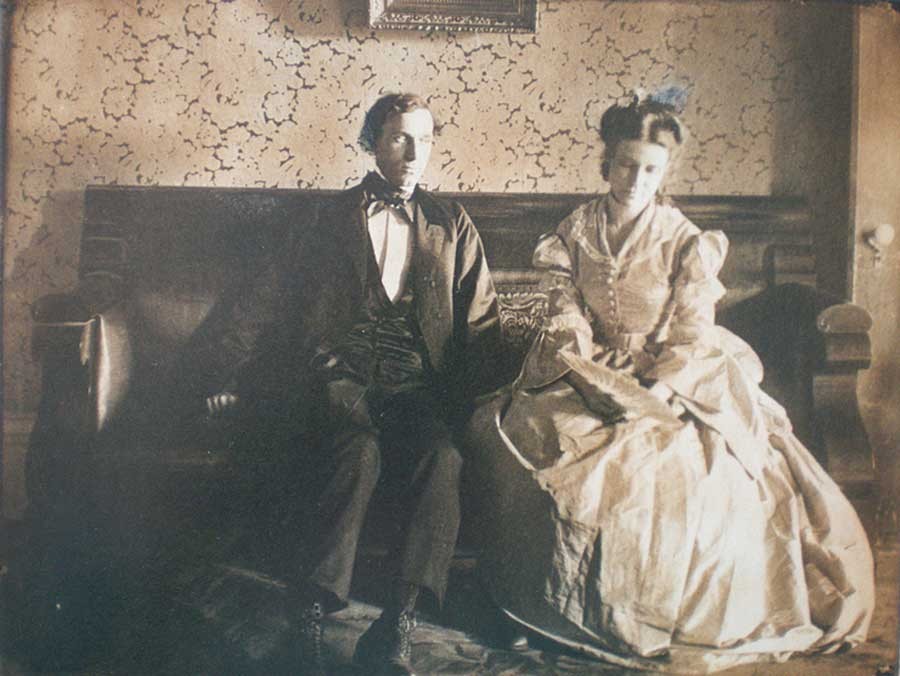 Clarence H. White: American: 1902: "She was still looking down at the fan": vintage Platinum or gelatin silver print: Showing typical retouching by White, the models are Alfred Dodge Cole, (1861-1928) a professor of Chemistry and Physics at Denison University and his wife Emily Downer Cole. (1865-1957) They play the roles of William Brower and Hope, whom Brower eventually marries in the novel Eben Holden. The photograph was reproduced as a photogravure plate and included in the Edition de luxe. Curators at the Robbins Hunter Museum where this and other White photographs are held stated the photographer had taken family photographs of the Downer family on the lawn of the home in the late 1890's and so he "would have been familiar with the house and furnishings from that commission. It was common for Clarence White to ask acquaintances to pose for photographs, often in costumes that he would provide. The photographs for Eben Holden were staged with costumes from the Civil War era." Photograph courtesy: Collection of the Robbins Hunter Museum in the Avery Downer House, Granville, OH.
Clarence H. White: American: 1902: "She was still looking down at the fan": vintage Platinum or gelatin silver print: Showing typical retouching by White, the models are Alfred Dodge Cole, (1861-1928) a professor of Chemistry and Physics at Denison University and his wife Emily Downer Cole. (1865-1957) They play the roles of William Brower and Hope, whom Brower eventually marries in the novel Eben Holden. The photograph was reproduced as a photogravure plate and included in the Edition de luxe. Curators at the Robbins Hunter Museum where this and other White photographs are held stated the photographer had taken family photographs of the Downer family on the lawn of the home in the late 1890's and so he "would have been familiar with the house and furnishings from that commission. It was common for Clarence White to ask acquaintances to pose for photographs, often in costumes that he would provide. The photographs for Eben Holden were staged with costumes from the Civil War era." Photograph courtesy: Collection of the Robbins Hunter Museum in the Avery Downer House, Granville, OH.
Ultimately, Stieglitz’s publishing background, connections and established relationship with White through his editorship of Camera Notes, his new involvement with Camera Work, as well as his having his own work exhibited in an early salon of pictorial photography in Newark Ohio in late 1900 and other exhibitions made Stieglitz a believer in White’s potential as an illustrator:
“What is especially fascinating, however, is what occurs when White is commissioned, as he was in 1901, to take up literary illustration himself. Through the assistance of Stieglitz, White received the commission to illustrate a new edition of the novel Eben Holden by Irving Bacheller. ( 4. )
And much later, the photographer’s grandson Maynard Pressley White commented about a bit of reluctance on his grandfather’s part in dealing with Lothrop as part of his Ph.D. dissertation in 1975:
“The correspondence with Stieglitz concerning the illustrations for Eben Holden is revealing of his character as well as Stieglitz informed him that he suffered from no such timidity and would—and indeed did—handle the matter with the publishers, as it turned out, to the advantage of White.” (5.)
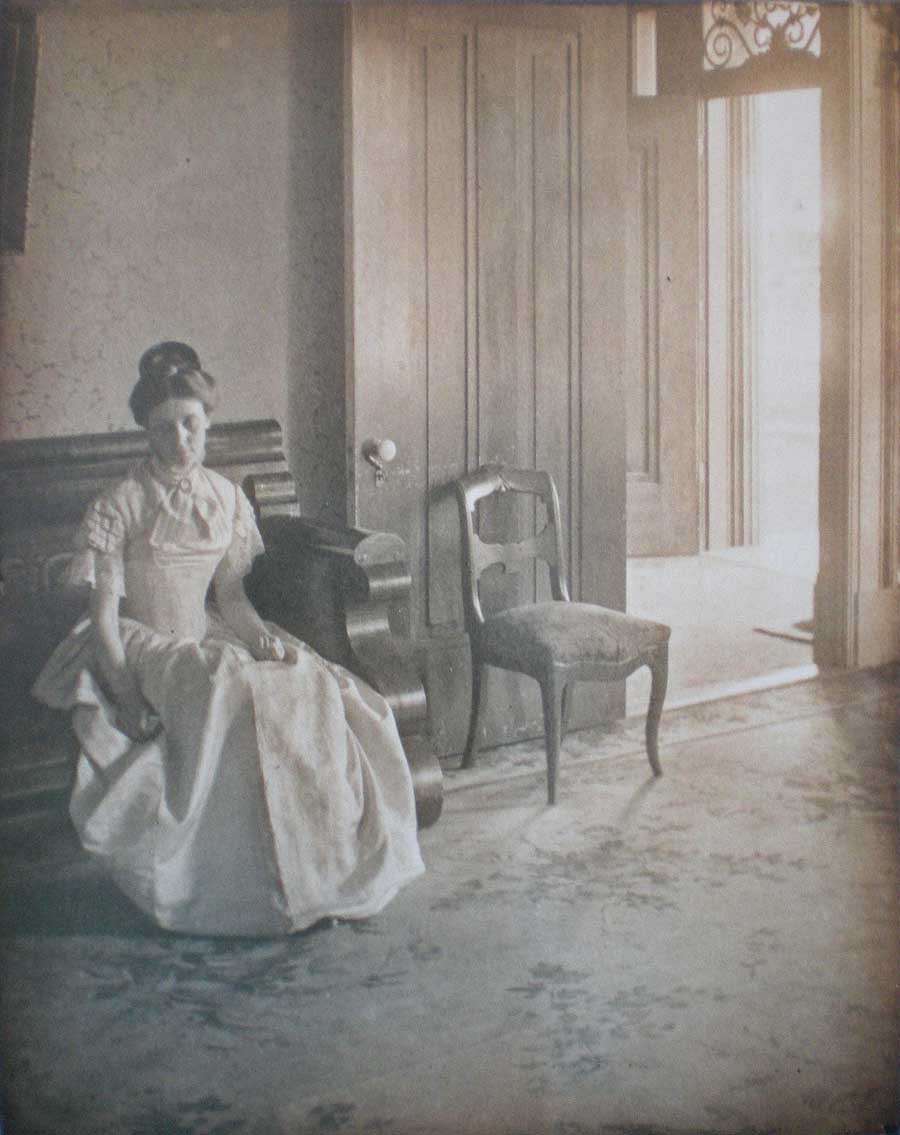 Clarence H. White: American: 1902? : vintage untitled Platinum or gelatin silver print: The model Emily Downer Cole (1865-1957) poses wearing a different dress than seen in the published Eben Holden photogravure "She was still looking down at the fan" taken on the same settee in the front parlor of the Downer family home. This was likely an alternate study Clarence White took for consideration for his series of Eben Holden illustrations. Photograph courtesy: Collection of the Robbins Hunter Museum in the Avery Downer House, Granville, OH.
Clarence H. White: American: 1902? : vintage untitled Platinum or gelatin silver print: The model Emily Downer Cole (1865-1957) poses wearing a different dress than seen in the published Eben Holden photogravure "She was still looking down at the fan" taken on the same settee in the front parlor of the Downer family home. This was likely an alternate study Clarence White took for consideration for his series of Eben Holden illustrations. Photograph courtesy: Collection of the Robbins Hunter Museum in the Avery Downer House, Granville, OH.
John Andrew & Son: founded in Boston: 1852
In giving credit to White and the firm that printed his photographs as gravures, a bit of elucidation seems in order to set things straight. Upon close inspection of these plates along with many others by Boston’s John Andrew & Son from the same time frame, I feel confident giving the Andrew firm credit for printing them. This is based on a near exact match in the script font used for the plate titles in the de luxe edition of Eben Holden as well as those plates credited to the firm appearing in the Photographic Times Bulletin from 1902-04.
I’ve included examples of the font as a comparison with this post. Another exact match is the same plate paper was used for both publications: this is very revealing especially on the plate verso where a very fine stipple pattern can be seen on the paper surface of the cream-colored plate paper. Perhaps the strongest association with the John Andrew atelier and the Norwood Press (which printed the de luxe edition) emerged in my research on business associations with some of the individual companies that came together in 1894 when that press was formed. These included J.S. Cushing & Co., (for composition and typesetting) Berwick & Smith Co., (for presswork) and E. Fleming & Co. (for binding). Beginning around 1890, all of these firms along with John Andrew were under one roof as part of the brand new Dana Estes & Company publishing house buildings on Summer Street in Boston.
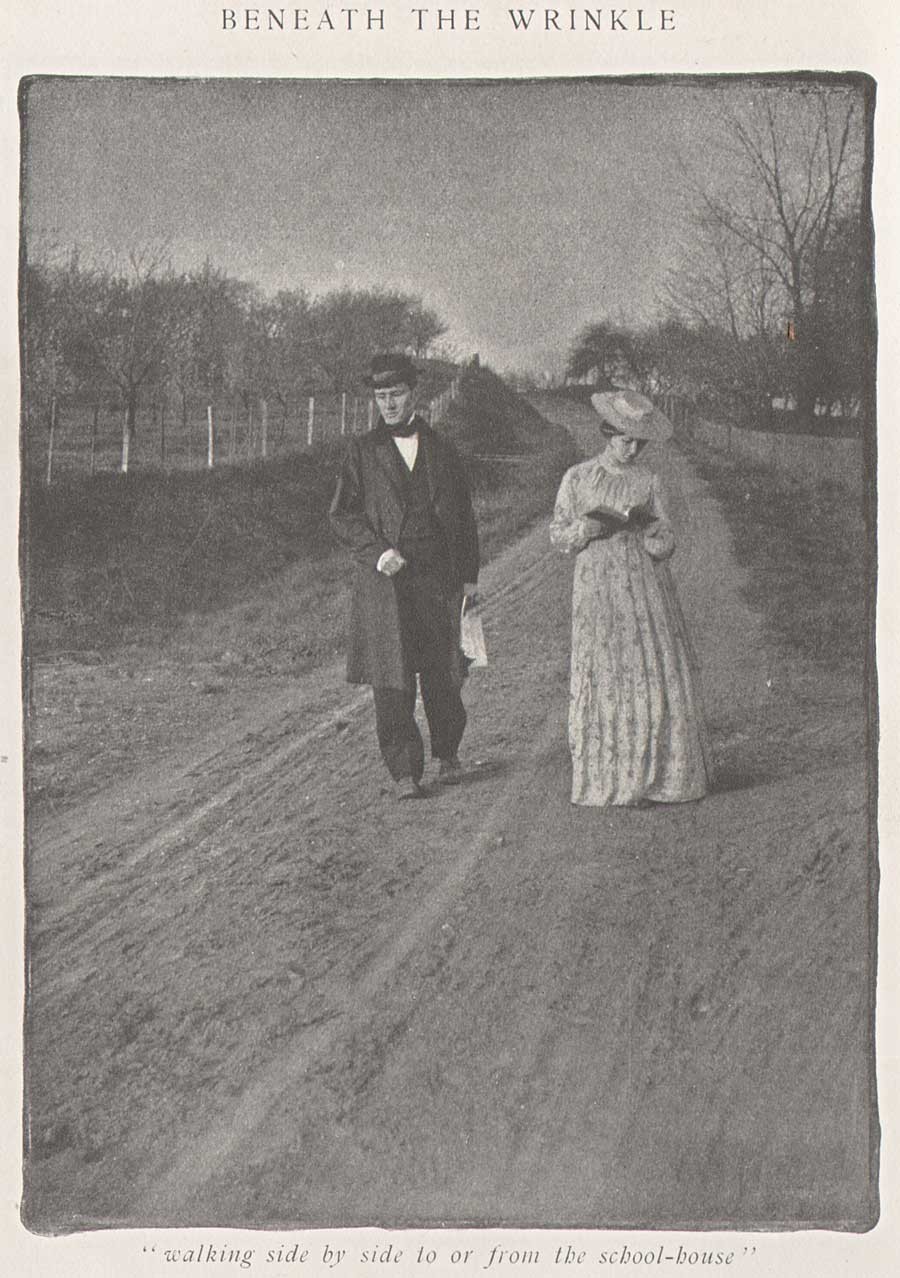 Clarence H. White: American: 1903: halftone: "Walking side by side to or from the school-house" was one of three photographs published to illustrate the Clara Morris story "Beneath the Wrinkle" published in the February, 1904 issue of McClure's Magazine. (12.8 x 9.5 cm) published: p. 430. From: PhotoSeed Archive
Clarence H. White: American: 1903: halftone: "Walking side by side to or from the school-house" was one of three photographs published to illustrate the Clara Morris story "Beneath the Wrinkle" published in the February, 1904 issue of McClure's Magazine. (12.8 x 9.5 cm) published: p. 430. From: PhotoSeed Archive
With the move to Norwood in 1894, the Andrew atelier stayed behind in Boston at 196 Summer St. but continued to provide fine photo engraving work to the major publishing houses in Boston and New York. Known today for printing many of the photogravure plates beginning in 1907 for the monumental Edward Sheriff Curtis work The North American Indian, the firm sometime in the first decade of the 20th Century became a department of the Suffolk Engraving & Electrotyping Co. of Boston with offices at 394 Atlantic Ave.
Named after John Andrew, (1815-1870) a wood engraver born in England who immigrated to Boston where he worked with fellow engraver Andrew Filmer, the firm eventually made the transition to photo engraving, including the half tone and photogravure processes. Andrew’s son George T. Andrew succeeded his father at the business, located at 196 Summer St. An 1892 overview of the firm from the volume Picturesque Hampden gives some background:
JOHN ANDREW & SON COMPANY.
ENGRAVERS AND MAKERS OF FINE BOOKS, BOSTON MASS.
If we go back a few years, we find that in illustrating books and magazines wood and steel engraving were about the only methods available. Nor could steel engraving have any wide use on account of the great expense of printing. Ever since its start, in 1852, the firm, now styled the John Andrew & Son Company, has held a prominent place among illustrators, especially in work of the finest grades. Their reputation was made in the first place as engravers on wood, but the discovery of delicate chemical and mechanical processes has in later years led them to also take the photo-engraving and half-tone work which has at present such wide use and popularity. In this field they do work for some of the best magazines and books published in this country. In what they undertake they strive not so much to do the cheapest work in price as the best work in quality. Quite recently the firm has taken up the photo-gravure process in addition to those spoken of above. The industry we describe is not located in Hampden county, but the mention here is not inappropriate as the engraving of our pen and ink pictures was done almost wholly by this firm. Their address is 196 Summer street, Boston.
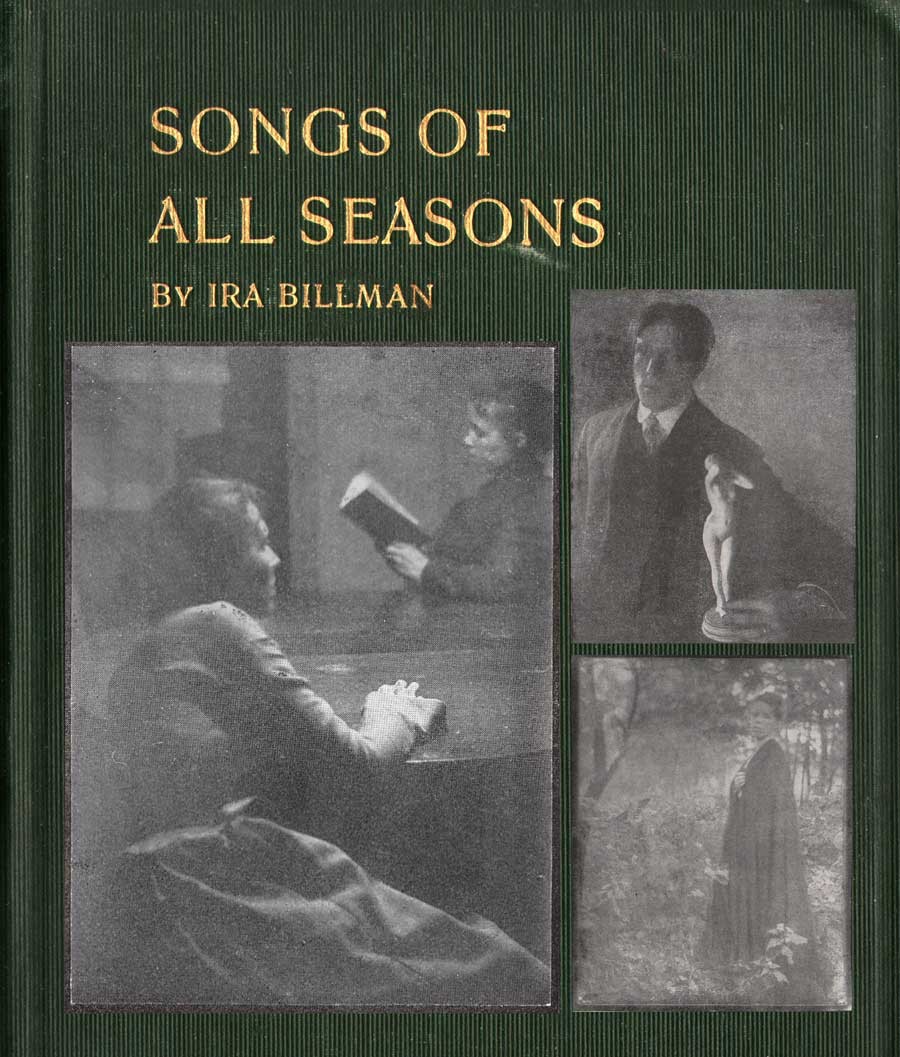 Detail: Cover for "Songs of All Seasons" by Ira Billman. The Hollenbeck Press, Indianapolis: 1904. Gilt-engraved stamped cloth: 20.4 x 13.6 cm: shown inset with representative photographs taken by Clarence White reproduced in halftone in the volume. Photo left: "The Book Lovers" (p. 181); top right: untitled man with statuette illustrating poem "The Twin Flower" (p.137); bottom right: "The Gloaming" (p. 199). Billman was Clarence White's uncle and was "one of his earliest artistic influences in his life": From: PhotoSeed Archive
Detail: Cover for "Songs of All Seasons" by Ira Billman. The Hollenbeck Press, Indianapolis: 1904. Gilt-engraved stamped cloth: 20.4 x 13.6 cm: shown inset with representative photographs taken by Clarence White reproduced in halftone in the volume. Photo left: "The Book Lovers" (p. 181); top right: untitled man with statuette illustrating poem "The Twin Flower" (p.137); bottom right: "The Gloaming" (p. 199). Billman was Clarence White's uncle and was "one of his earliest artistic influences in his life": From: PhotoSeed Archive
Photographic Illustration: a New Outlet
A newspaper clipping, believed to be from the Newark Daily Advocate in the Clarence Hudson White clipping file at the Newark, OH public library, includes the following undated (but 1903) story discussing Eben Holden in passing while concentrating on a new commission that inevitably came from it: costume-piece photographs by White similar to those he did for Lothrop for author Clara Morris’s story published in McClure’s magazine in February, 1904 entitled “Beneath the Wrinkle”:
PICTURES From Real Life by Clarence White
Forwarded On Order to a New York Magazine-Local Artist’s Latest Work.
Mr. Clarence White received a command last fall from the art department of McClure’s Magazine to illustrate Clara Morris’ new story, entitled, “Beneath the Wrinkle,” that will appear in that magazine presumably in the near future. Mr. White was to have been given all the time he wanted, but in view of the change of art editors, Mr. White was notified about three weeks ago that the illustrations would be required immediately. Mr. White at once notified the publishers that he would use all his efforts to complete them immediately, and would forward them when completed. Today the set comprising six, were forwarded and as equaly as clever and well executed as the ones made for the illustrating of the holiday edition of Eben Holden that was to have made its appearance last Christmas, but was not completed in time for that season. The ones now in progress are all local personages, done in quaint, old-fashioned garb and surroundings, recalling vividly to mind the characteristics in dress and decorations then in vogue. They show the fine and beautiful artistic temperament of Mr. White in his striking correct interpretation of dress and customs of the period in which the characters live. Mr. White deserves the honor the illustrations will surely bring to him, as he is always conscientious and painstaking in whatever he undertakes in his profession.
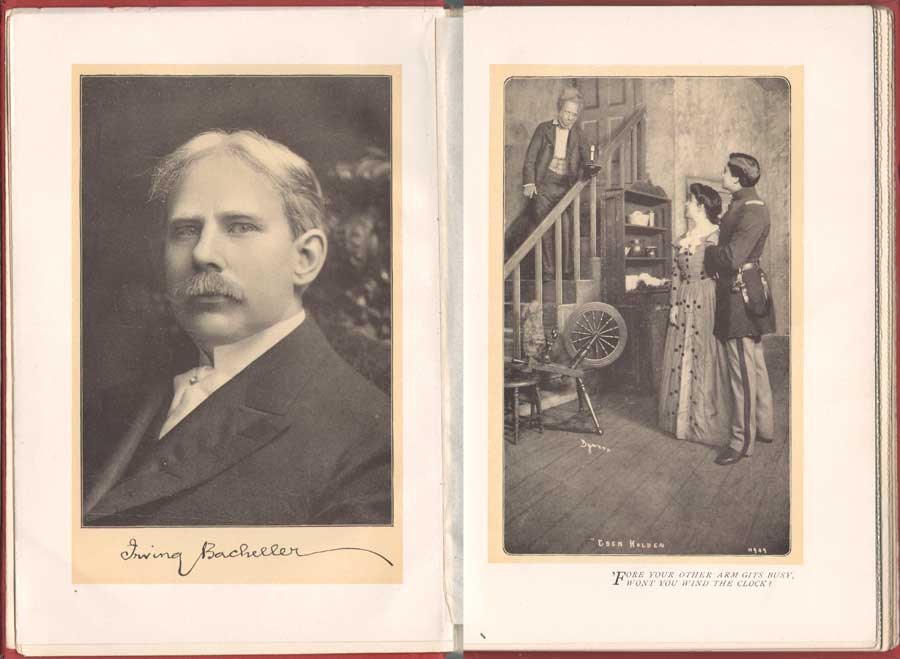 Left: Irving Bacheller, (1859-1950) American journalist and author, wrote the novel Eben Holden which sold over 1 million copies. This portrait with facsimile autograph by an unknown photographer appeared as the frontis (13.3 x 9.1 cm) to the Dramatic Edition of the book-the first illustrated edition featuring photographs of the Broadway stage production that debuted Oct. 28, 1901 and ran for only 49 performances. Right: " 'Fore your other arm gits busy, wont you wind the clock?" (14.1 x 8.4 cm) Actor E.M. Holland at left plays the role of Eben Holden, Lucille Flaven plays Hope and Earle Ryder as an American Civil War officer plays William Brower. The important New York commercial photographer Joseph Byron, (1847-1923) founder of the Byron Company (currently, the 7th & 8th generations runs Byron Photography) took stage photographs of the play at New York's Savoy Theatre with plates published in the Dramatic Edition. from: PhotoSeed Archive
Left: Irving Bacheller, (1859-1950) American journalist and author, wrote the novel Eben Holden which sold over 1 million copies. This portrait with facsimile autograph by an unknown photographer appeared as the frontis (13.3 x 9.1 cm) to the Dramatic Edition of the book-the first illustrated edition featuring photographs of the Broadway stage production that debuted Oct. 28, 1901 and ran for only 49 performances. Right: " 'Fore your other arm gits busy, wont you wind the clock?" (14.1 x 8.4 cm) Actor E.M. Holland at left plays the role of Eben Holden, Lucille Flaven plays Hope and Earle Ryder as an American Civil War officer plays William Brower. The important New York commercial photographer Joseph Byron, (1847-1923) founder of the Byron Company (currently, the 7th & 8th generations runs Byron Photography) took stage photographs of the play at New York's Savoy Theatre with plates published in the Dramatic Edition. from: PhotoSeed Archive
White Family Connections: Songs of all Seasons
During the time he received the commission for illustrating Beneath the Wrinkle in 1903, a more intimate family connection developed which allowed White the opportunity to take another series of photographic illustrations, 42 in all, published in 1904 within a slim volume of poetry titled Songs of All Seasons.
The author was nationally known poet Ira Billman, Clarence White’s uncle, the brother of his mother Phoebe Billman White. In the volume Symbolism of Light: The Photographs of Clarence H. White published in 1977 which accompanied an exhibition of White’s work at the Delaware Art Museum and International Center of Photography, White’s grandson Maynard P. White, Jr. describes Ira Billman as a major influence on Clarence and Songs:
Among the gathering of aunts and uncles that gave meaning and context to the artist’s early life was Ira Billman, his mother’s brother. “Poetic” is the word most often used to describe White’s photography, and his Uncle Ira, a poet by avocation, was one of the earliest artistic influences in his life. …Billman’s work celebrates rural America; his poems are songs to people and to nature, and they are imbued with the deep religious sentiments of his Lutheran heritage, without being mawkish or even faintly cloying. What is important for the purpose of my discussion is that Clarence White made the photographic illustrations for Songs of All Seasons, and Billman dedicated the volume to him. (7.)
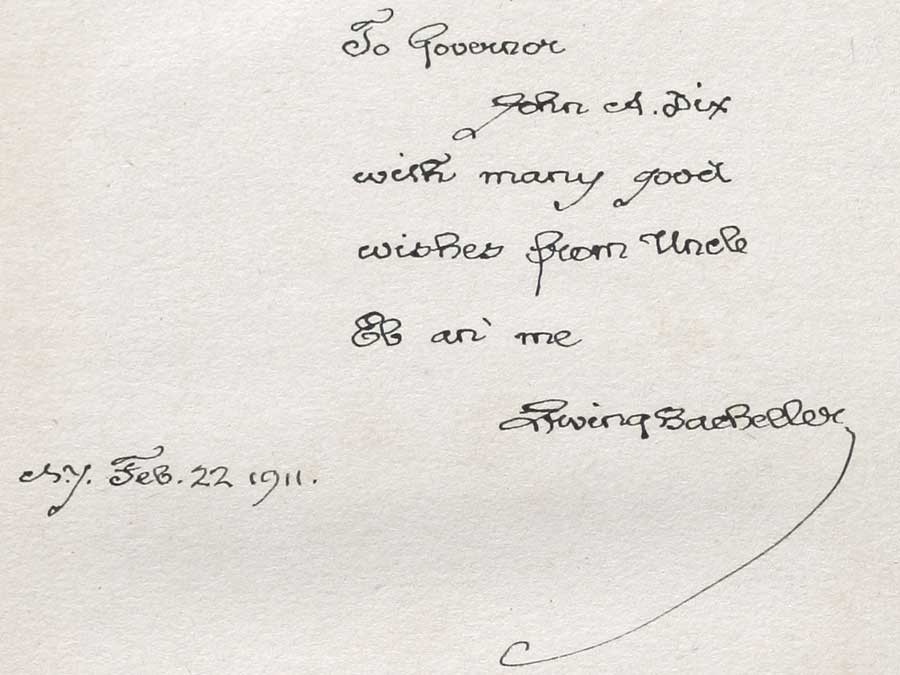 "To Governor John A. Dix with many good wishes from Uncle Eb an' me Irving Bacheller N.Y. Feb. 22 1911." This personal inscription by Bacheller to John A. Dix, then Governor of New York State, appears in a volume of Eben Holden with the imprint of Two Hundred and Seventieth Thousand, September 18, 1903, the actual year the novel was released for sale. In a 1901 newspaper article, Bacheller said the character Eben Holden was based on "a composite of my father and his hired man-a very jolly old fellow". from: PhotoSeed Archive
"To Governor John A. Dix with many good wishes from Uncle Eb an' me Irving Bacheller N.Y. Feb. 22 1911." This personal inscription by Bacheller to John A. Dix, then Governor of New York State, appears in a volume of Eben Holden with the imprint of Two Hundred and Seventieth Thousand, September 18, 1903, the actual year the novel was released for sale. In a 1901 newspaper article, Bacheller said the character Eben Holden was based on "a composite of my father and his hired man-a very jolly old fellow". from: PhotoSeed Archive
Ninety-one poems and sonnets are included in the volume. Here, The Test, a representative poem from the work:
The Test
Not what I felt will be the test
When song and fragrance filled the hour,
And all the sunshine of the blest
Unfolded me to perfect flower.
Not what I aid will be the test
When by sweet waters wound my way,
And white-haired, thoughtful hills all guessed
The word I was about to say.
Not what I did will be the test
When stunned by cry of human needs
I dreamed I was myself oppressed,
And woke to passion of great deeds.
Not what I chose will be the test
When first I saw one world in hand
Is worth two in the bush-the best
Of which it is to understand.
O! none of these will be the test,
But what God knows I would have done,
Had I been nurtured in the nest
Of one, I now condemn and shun. (8.)
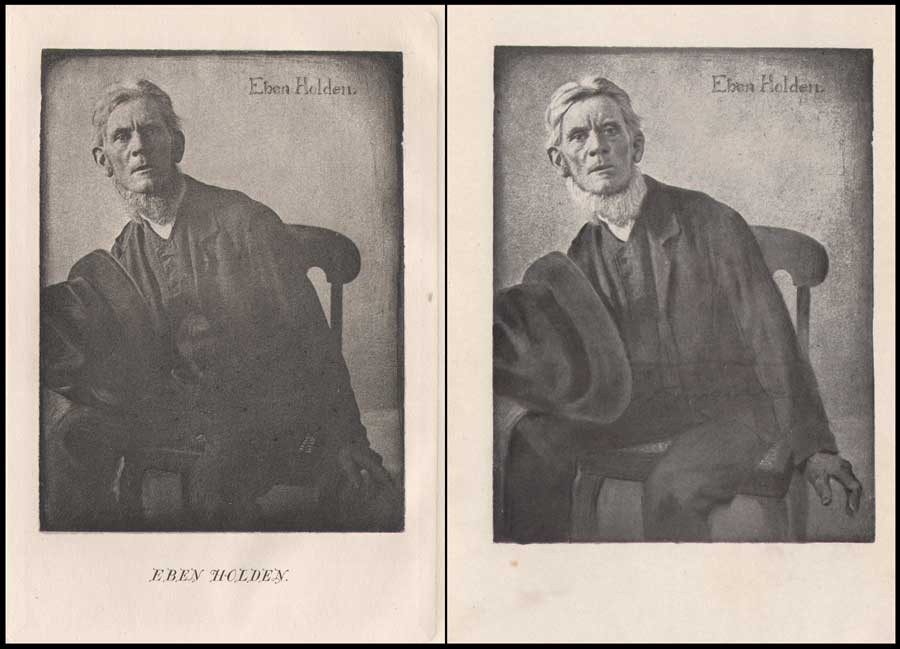 Left: Clarence H. White: American: 1902: hand-pulled photogravure: (9.7 x 7.3 cm) in: Eben Holden: A Tale of the North Country: Boston: Lothrop Publishing. (1903) Appearing as the frontis portrait in the Edition de luxe, this unknown subject was the novel's namesake: a fictional character who was a former farm-hand and main father figure for the newly orphaned William Brower serving as the narrator in the work. Right: Clarence H. White: American: 1902: halftone: (12.0 x 9.2 cm) in: Eben Holden: Harper & Brothers Publishers. (1914) Part of the Pine Tree Edition of Irving Bacheller's (Collected) Works. This heavily manipulated portrait from the original photograph by Clarence White of Eben Holden published 11 years earlier also appeared as the frontis for the first volume in the Pine Tree series. From: PhotoSeed Archive
Left: Clarence H. White: American: 1902: hand-pulled photogravure: (9.7 x 7.3 cm) in: Eben Holden: A Tale of the North Country: Boston: Lothrop Publishing. (1903) Appearing as the frontis portrait in the Edition de luxe, this unknown subject was the novel's namesake: a fictional character who was a former farm-hand and main father figure for the newly orphaned William Brower serving as the narrator in the work. Right: Clarence H. White: American: 1902: halftone: (12.0 x 9.2 cm) in: Eben Holden: Harper & Brothers Publishers. (1914) Part of the Pine Tree Edition of Irving Bacheller's (Collected) Works. This heavily manipulated portrait from the original photograph by Clarence White of Eben Holden published 11 years earlier also appeared as the frontis for the first volume in the Pine Tree series. From: PhotoSeed Archive
Pictorial Illustration for Photography a Growing Field
By 1904, esteemed critic Sadakichi Hartman, writing in Leslie’s Weekly, weighed in on the growing use of photography for book illustration:
”…and Clarence H. White, of Newark, O., has found a new opening for photography in the illustration of books. His illustrations for “Eben Holden” have attracted wide and deserved attention.” (9.)
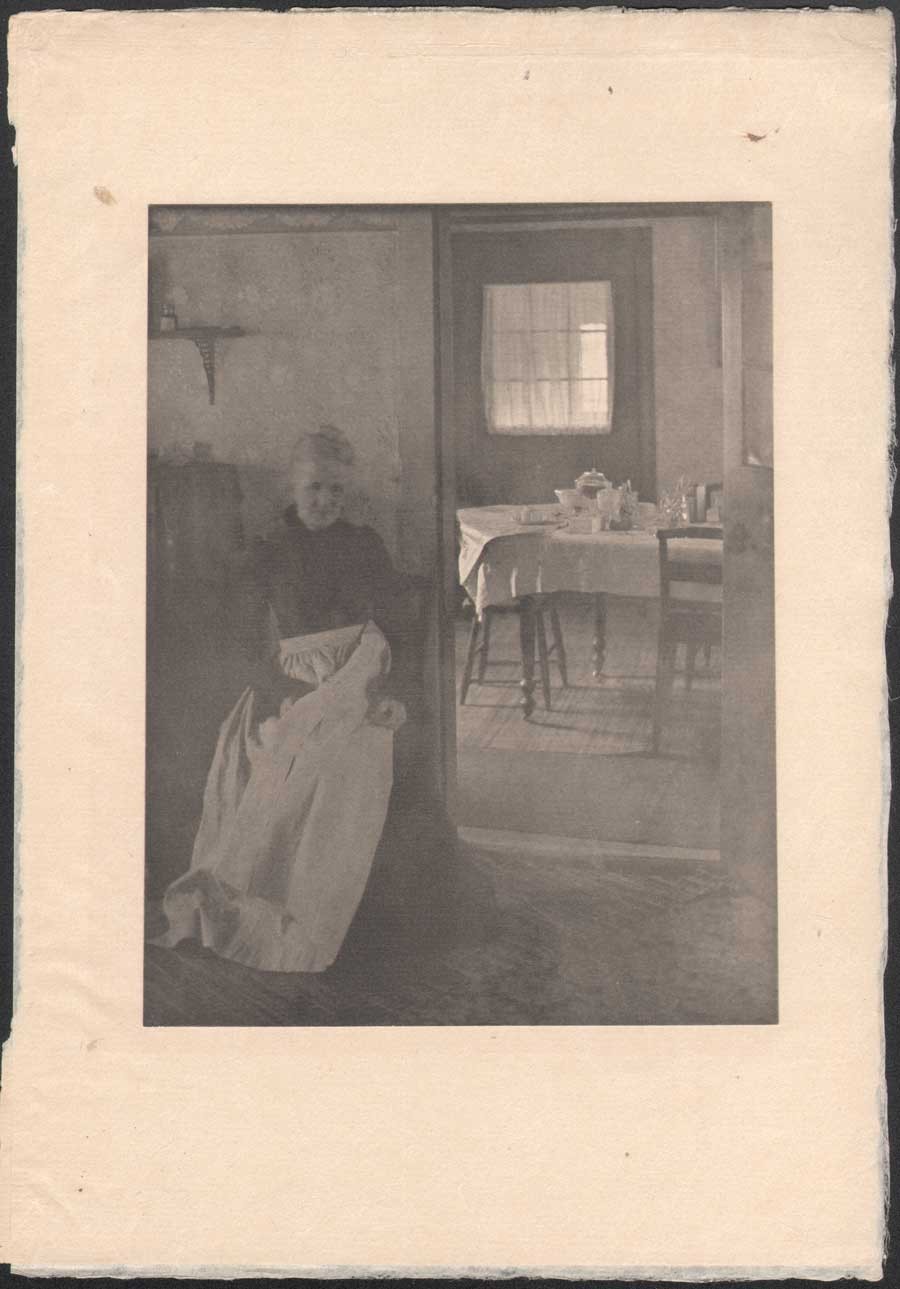 Clarence H. White: American: 1902: "Illustration to "Eben Holden"" (1903) hand-pulled photogravure: (tipped image:19.7 x 15.0 cm | Japan paper support: 30.5 x 21.0 cm) in: Camera Work III. (1903) Two plates in the Edition de luxe of Eben Holden: "How much was that a yard ?" (seen in this post-CW IX: 1905) and this one: "Mother was living in the old home alone"-an interior portrait of the photographer's mother Phoebe Billman White (1845-1920) were also published as photogravures in Camera Work. From: PhotoSeed Archive
Clarence H. White: American: 1902: "Illustration to "Eben Holden"" (1903) hand-pulled photogravure: (tipped image:19.7 x 15.0 cm | Japan paper support: 30.5 x 21.0 cm) in: Camera Work III. (1903) Two plates in the Edition de luxe of Eben Holden: "How much was that a yard ?" (seen in this post-CW IX: 1905) and this one: "Mother was living in the old home alone"-an interior portrait of the photographer's mother Phoebe Billman White (1845-1920) were also published as photogravures in Camera Work. From: PhotoSeed Archive
And later that year, citing White’s involvement with Eben Holden while writing in the Photographic Times Bulletin, Hartman brought up the potential financial rewards possible for pictorial photographer in this new field:
“The only way to approximate a market value of pictorial prints is to investigate how much they might bring on the average, if offered for sale as illustrations. There is lately a decided demand for photographic illustrations, and consequently a certain standard price in vogue. The pictorialist, of course, and perhaps with some right, aspires to illustrator’s prices (i.e., $50-$100 for the full page of a magazine), but he has never reached it, with the one exception of Clarence H. White, who is said to have received several hundred dollars for his series of “Eben Holden” illustrations.” (10.)
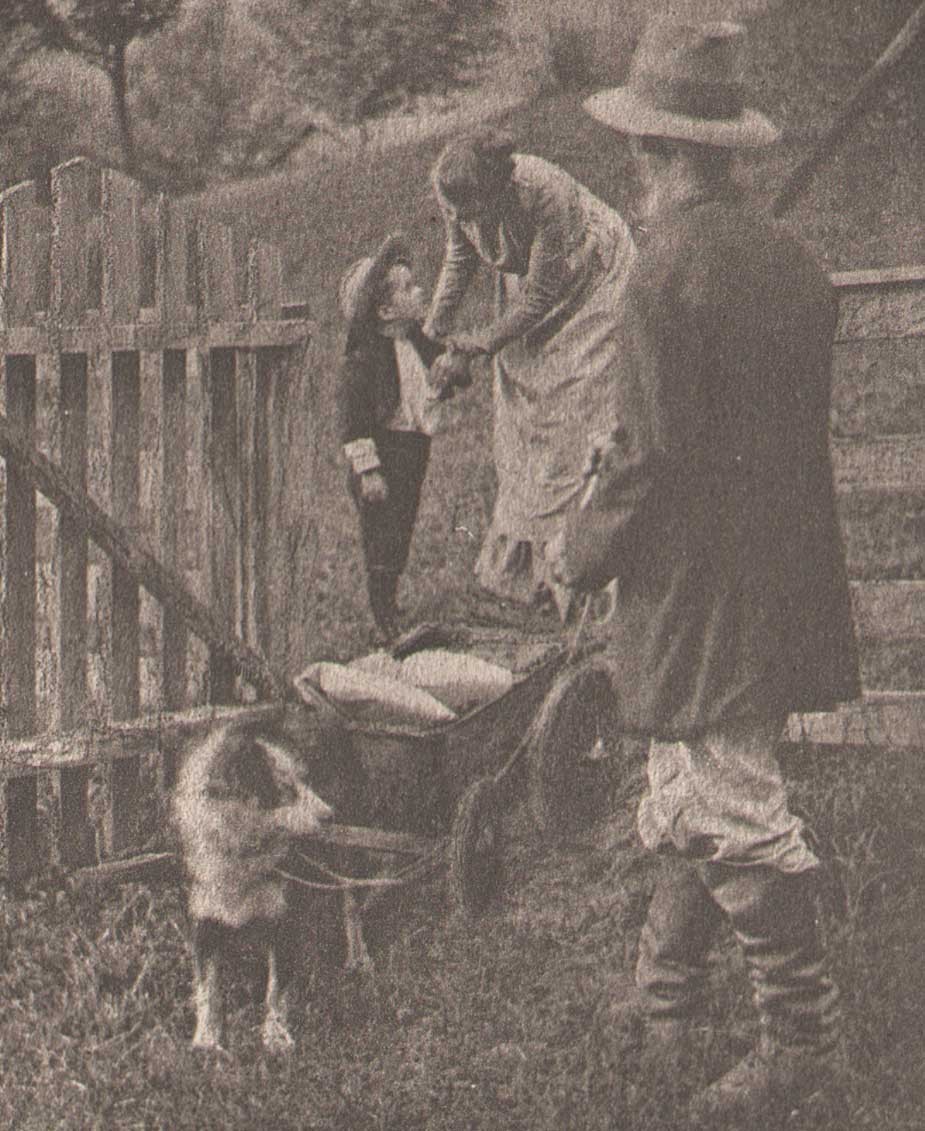 Detail: "Tucked some cookies into my pocket" : Clarence H. White: American: 1902: hand-pulled photogravure plate (11.9 x 7.3 cm) included with Edition de luxe of Eben Holden (1903): Lothrop Publishing, Boston. The young orphan William Brower is possibly modeled here by the photographer's son Maynard Pressley White (b. 1896) and his wife Jane Felix. (1869-1943) The scene shows Brower preparing to head out into the wilderness in a dog-pulled cart with Eben Holden at right. From the novel: "Our hostess met us at the gate and the look of her face when she bade us good-by and tucked some cookies into my pocket, has always lingered in my memory and put in me a mighty respect for all women." From: PhotoSeed Archive
Detail: "Tucked some cookies into my pocket" : Clarence H. White: American: 1902: hand-pulled photogravure plate (11.9 x 7.3 cm) included with Edition de luxe of Eben Holden (1903): Lothrop Publishing, Boston. The young orphan William Brower is possibly modeled here by the photographer's son Maynard Pressley White (b. 1896) and his wife Jane Felix. (1869-1943) The scene shows Brower preparing to head out into the wilderness in a dog-pulled cart with Eben Holden at right. From the novel: "Our hostess met us at the gate and the look of her face when she bade us good-by and tucked some cookies into my pocket, has always lingered in my memory and put in me a mighty respect for all women." From: PhotoSeed Archive
This additional source of significant money to Clarence White and his young family through these illustration commissions invariably gave him additional confidence in his abilities as a photographer and financial peace of mind to eventually make his way to New York City, leaving Newark in 1906. It is also not a stretch to infer White’s own life mimicked the storyline of hard work that can earn the “American Dream” found between the pages of Eben Holden. Although the critic for the New York Times reviewing the play at New York’s Savoy theater didn’t care too much for the acting:
”As an exhibition of dramatic craft “Eben Holden” is hardly worth serious consideration“…
he did, a few paragraphs later, write the production had a few redeeming qualities:
But, despite its defects, the play is wholesome; it is redolent of the woods and the fields, and it provides the opportunity for an evening of entertainment that need not be looked back upon with regret. (11.)
No doubt Clarence White, had he been in attendance watching the play inside Newark’s Auditorium that 1904 November evening, would have agreed with these last sentiments of the big city critic, marveling and grinning to himself in the darkened hall while taking in the surreal juxtaposition that art imitating life can bring about.
Notes:
1. (White, Clarence H.) excerpt: An Annotated Bibliography on Pictorial Photography: Selected Books from the Library of Christian A. Peterson: Laurence McKinley Gould Library: Carleton College: Northfield, Minnesota: 2004
2. ABE listing: 120407. Besides multiple copies held by PhotoSeed, other known copies are in the Library of Congress, MOMA and Photogravure.com.
3. The Bookseller-Devoted to the Book and News Trade: Chicago: January, 1902: p. 28
4. Peter C. Bunnell: Inside the Photograph: writings on Twentieth-Century Photography: Aperture Foundation: 2006: p. 47
5. Clarence H. White : a personal portrait: Maynard Pressley White: Ph.D. dissertation, University of Delaware, 1975: pp. 79-80
6. see Beaumont Newhall’s Photography: A Short Critical History, from 1938, lists Eben Holden with the White illustrations as being published in 1903 on p. 215
7. excerpt: see Symbolism of Light: 1977: p. 7
8. Songs of All Seasons: Ira Billman: Indianapolis: The Hollenbeck Press: 1904: p. 65
9. excerpt: Advances in Artistic Photography: Sidney Allan: in: Leslie’s Weekly: April 28, 1904: New York: p. 388
10. excerpt: from: What is the Commercial Value of Pictorial Prints?: Sidney Allen: in: The Photographic Times Bulletin: December, 1904: p. 539
11. excerpt: review: “Eben Holden” at the Savoy: The New York Times, October 29, 1901
Genre meets Genius
Posted November 2014 in Engraving, New Additions, Painters|Photographers, Significant Photographers, Typography
Although long forgotten, amateur photographer John E. Dumont (1856-1944) figures prominently in the early years of American pictorial photography. However, a professional and better known acquaintance of his may change our understanding after my discovery of a small label on the back of a Dumont print made its’ way into the archive.
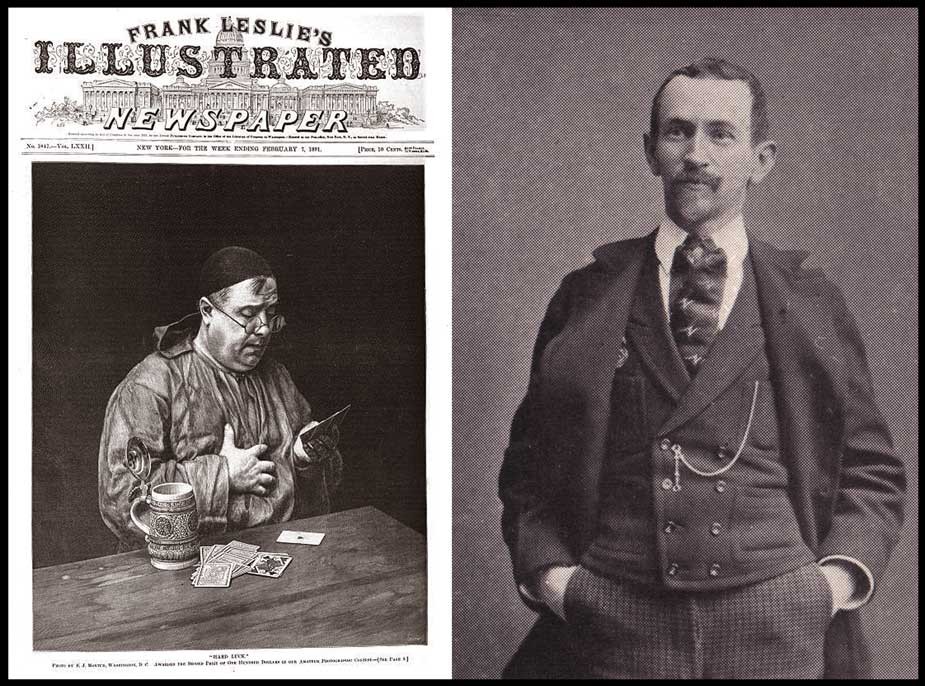 Left: "Hard Luck", showing a monk playing a losing hand of cards, was most likely taken by John E. Dumont in 1890. Shown here as the cover illustration of Frank Leslie's Illustrated Newspaper for Feb. 7, 1891, it is reproduced as a wood engraving from the original photograph, and earned Dumont a second place award and $100.00 in Leslie's Amateur Photographic Contest which closed in January, 1891. Dumont went on to copyright "Hard Luck" in 1892. (original from Pennsylvania State University) Right: Halftone portrait of photographer John E. Dumont of Rochester, New York by unknown photographer. 6.3 x 4.7 cm. Reproduced as part of a series of portraits of "Prominent Amateur Photographers" in the Nov., 1893 issue of the American Amateur Photographer journal. (p. 513) : from: PhotoSeed Archive
Left: "Hard Luck", showing a monk playing a losing hand of cards, was most likely taken by John E. Dumont in 1890. Shown here as the cover illustration of Frank Leslie's Illustrated Newspaper for Feb. 7, 1891, it is reproduced as a wood engraving from the original photograph, and earned Dumont a second place award and $100.00 in Leslie's Amateur Photographic Contest which closed in January, 1891. Dumont went on to copyright "Hard Luck" in 1892. (original from Pennsylvania State University) Right: Halftone portrait of photographer John E. Dumont of Rochester, New York by unknown photographer. 6.3 x 4.7 cm. Reproduced as part of a series of portraits of "Prominent Amateur Photographers" in the Nov., 1893 issue of the American Amateur Photographer journal. (p. 513) : from: PhotoSeed Archive
Established in business beginning in 1881 in Rochester, New York as a wholesale merchandise and grocery broker specializing in items like sugars, teas, and coffees, Dumont took up photography in 1884 and was soon entering and winning awards in photographic salons around the world.
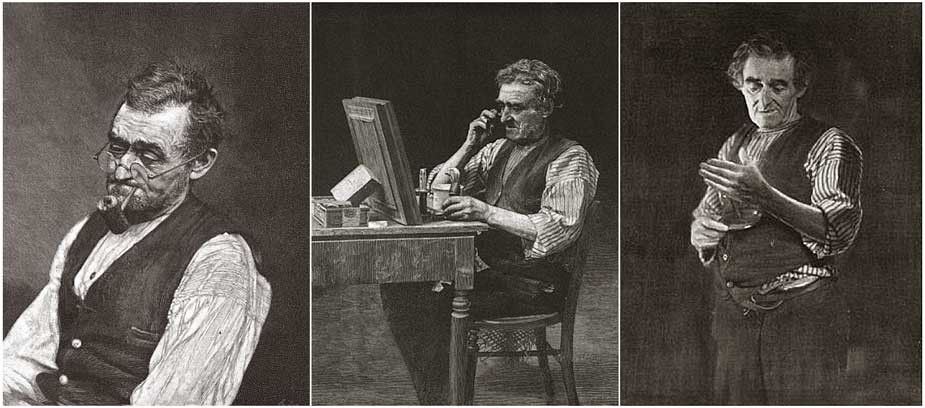 Taken in 1887, photographer John E. Dumont of Rochester, New York made this series of genre portrait photographs of a gentleman he described as "an old man who used to peddle oranges around the streets and offices in this city". Left: "A Quite Pipe": woodcut engraved from a copyright photograph from Leslie's Illustrated Newspaper Amateur Photographic Contest: published Jan., 17, 1891. Middle: "The Old Shaver": woodcut engraved from a copyright photograph from Leslie's Illustrated Newspaper Amateur Photographic Contest: published Jan., 24, 1891. Right: "The Toiler's Good-Night" : woodcut engraved from a copyright photograph illustrating a poem from Leslie's Illustrated Weekly: published Dec., 14, 1893: originals from Pennsylvania State University
Taken in 1887, photographer John E. Dumont of Rochester, New York made this series of genre portrait photographs of a gentleman he described as "an old man who used to peddle oranges around the streets and offices in this city". Left: "A Quite Pipe": woodcut engraved from a copyright photograph from Leslie's Illustrated Newspaper Amateur Photographic Contest: published Jan., 17, 1891. Middle: "The Old Shaver": woodcut engraved from a copyright photograph from Leslie's Illustrated Newspaper Amateur Photographic Contest: published Jan., 24, 1891. Right: "The Toiler's Good-Night" : woodcut engraved from a copyright photograph illustrating a poem from Leslie's Illustrated Weekly: published Dec., 14, 1893: originals from Pennsylvania State University
Specializing in genre scenes, his photographs were published frequently, reaching a high point when his well known study of a monk playing a losing hand of cards titled Hard Luck was published as the cover illustration (converted to a wood engraving) for Frank Leslie’s Illustrated Newspaper in early 1891, the same year he won a grand diploma at the groundbreaking Vienna Salon of Photographic Art, the highest accolade awarded for the very few American entrants whose work was even accepted, including the now venerable Alfred Stieglitz, who had only come back to America from Europe the year before.
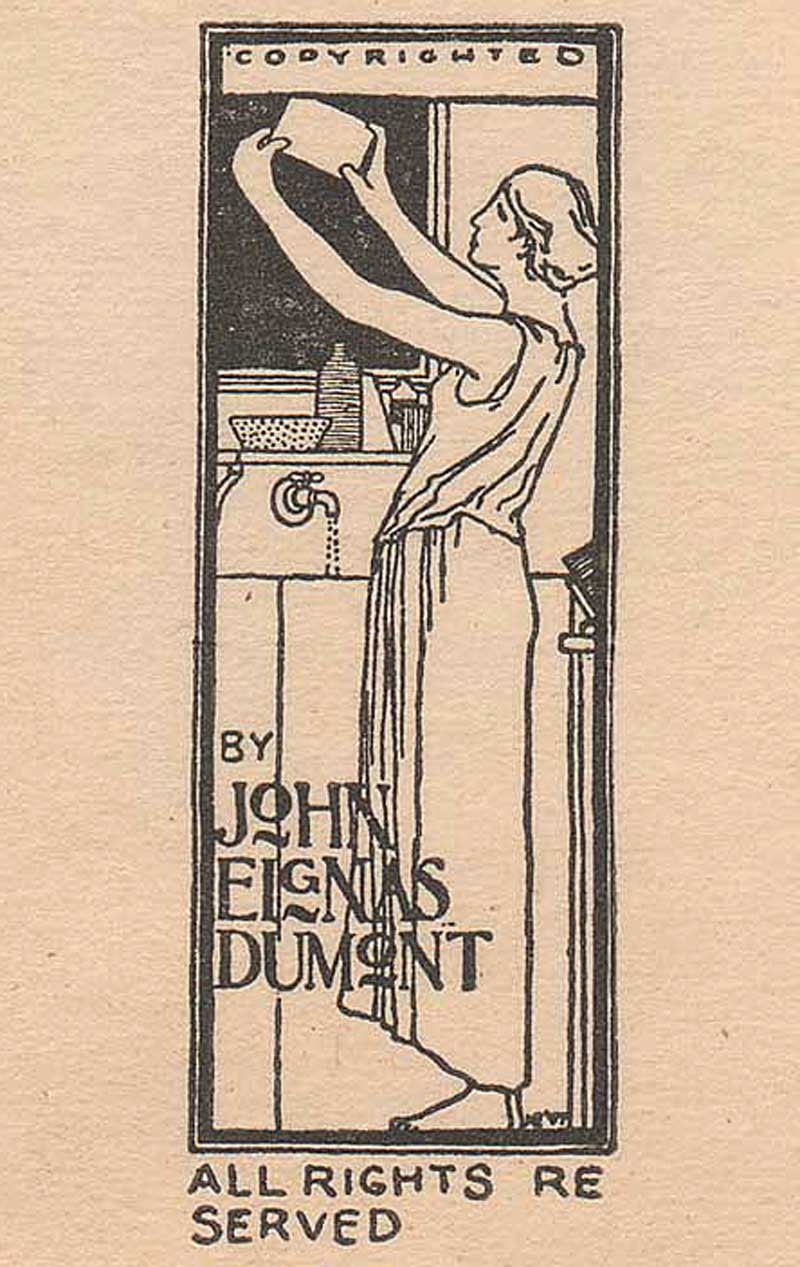 Artist: Harvey Ellis, American: 1897: medium: wood engraving: subject: copyright label for amateur American photographer John Eignas Dumont. Plate intended to represent "the genius of photography surrounded by the accessories of the "dark room." Design: 3.4 x 1.3 cm | Label: 7.0 x 4.5 cm. Label is a variant of an ex libris bookplate Ellis designed for Dumont. from: PhotoSeed Archive
Artist: Harvey Ellis, American: 1897: medium: wood engraving: subject: copyright label for amateur American photographer John Eignas Dumont. Plate intended to represent "the genius of photography surrounded by the accessories of the "dark room." Design: 3.4 x 1.3 cm | Label: 7.0 x 4.5 cm. Label is a variant of an ex libris bookplate Ellis designed for Dumont. from: PhotoSeed Archive
It was therefore a delightful discovery which took place for me recently after a signed Dumont carbon print of The Dice Players exhibited in the Royal Photographic Societies’ annual salon the same year as the Vienna exhibition was acquired for the archive. But what makes it special for the confluence of art photography and evidence a new incarnation of the English Arts & Crafts movement had taken hold after arriving on American shores was a later 1897 copyright label affixed to the rear of the mounted print. A design featuring an Art-Nouveau style woodcut engraving of a woman in a darkroom holding up a glass plate, I soon discovered it was the work of noted American artist, architect and designer Harvey Ellis. (1852-1904)
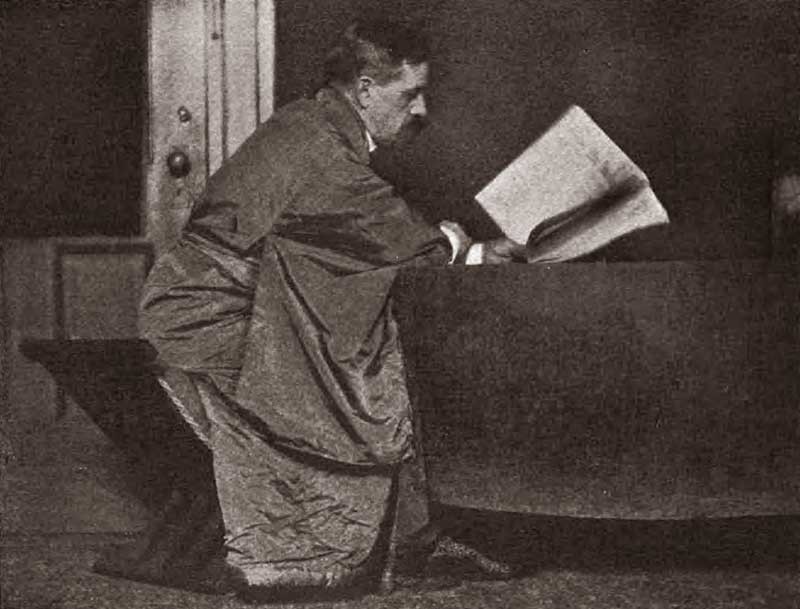 Photographic portrait of American artist, architect and designer Harvey Ellis. (1852-1904) unknown photographer: reproduced as halftone and published in the Dec., 1908 issue of The Architectural Review illustrating article on Ellis by Claude Bragdon titled Harvey Ellis: A Portrait Sketch: p. 173. Original from The University of Michigan
Photographic portrait of American artist, architect and designer Harvey Ellis. (1852-1904) unknown photographer: reproduced as halftone and published in the Dec., 1908 issue of The Architectural Review illustrating article on Ellis by Claude Bragdon titled Harvey Ellis: A Portrait Sketch: p. 173. Original from The University of Michigan
Never heard of him? Today, Ellis seems only to be remembered for the brief work he did in the last months of his life in 1903 for among other things, designing mission-style furniture and interior renderings of Craftsman homes in the Syracuse, New York-based architecture department for his American employer, Gustav Stickley, (1858-1942) the leader of the nascent American Arts and Crafts movement. But this is far from a full portrait of Ellis. A contemporary- architect, author, and theater designer Claude Bragdon- (1866-1946) gave a fuller account of Harvey Ellis in a posthumous outline for the December, 1908 issue of The Architectural Review. A few excerpts:
HARVEY ELLIS was a genius. This is a statement which may excite only incredulity in the minds of the many who never heard his name or knew him only by his published drawings, but it will have the instant concurrence of the few who knew well the man himself. There is the genius which achieves, and the genius which inspires others to achievement. Had it not been for the evil fairy (alcohol-editor) which presided at his birth and ruled his destiny, Harvey Ellis might have been numbered among the former; that is, he might have been a prominent, instead of an obscure, figure in that aesthetic awakening of America, now going on, of which he was among the pioneers; but even so he exercised an influence more potent than some whose names are better remembered. (p. 173)
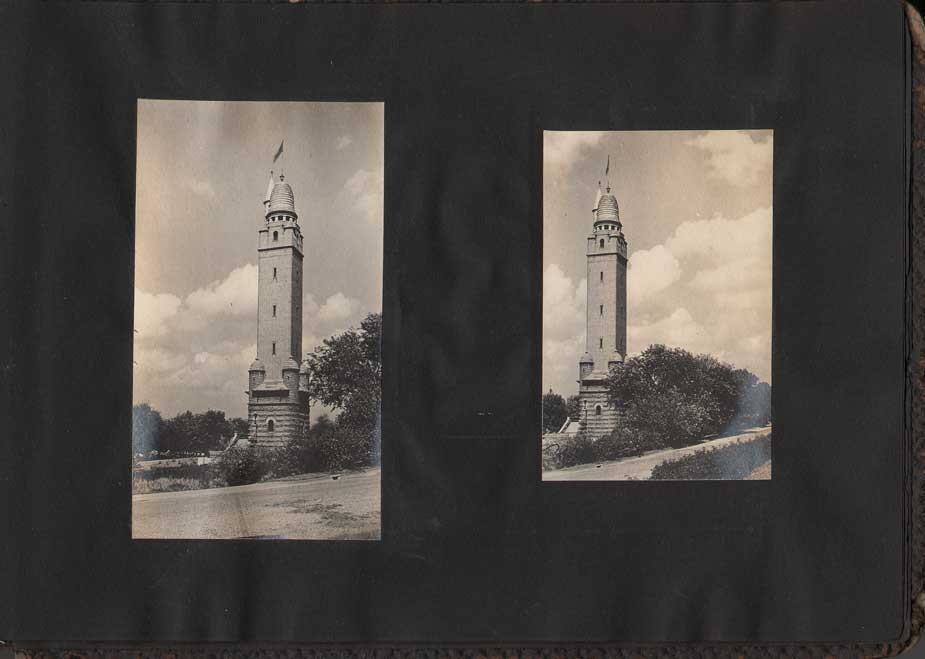 Although many designs by Harvey Ellis were never realized in the physical form, there are notable exceptions. The Compton Hill Water Tower in Reservoir Park, St. Louis, MO, is one landmark still standing. Topping out at 179 feet, (55 m) the structure was designed by Ellis in 1896 or 97 while employed by the St. Louis architectural firm of George R. Mann and Edmond J. Eckel, and built in 1898 in the French Romanesque style of rusticated limestone and buff brick and finished in terra cotta. The tower was decommissioned in 1929 and placed on the National Register of Historic Places in 1972. Photographer: Leo Kraft, American: ca. 1915: gelatin silver prints pasted in album: left: 12.1 x 6.9 cm | right: 9.8 x 6.3 cm : support: 17.6 x 25.2 cm. from: PhotoSeed Archive
Although many designs by Harvey Ellis were never realized in the physical form, there are notable exceptions. The Compton Hill Water Tower in Reservoir Park, St. Louis, MO, is one landmark still standing. Topping out at 179 feet, (55 m) the structure was designed by Ellis in 1896 or 97 while employed by the St. Louis architectural firm of George R. Mann and Edmond J. Eckel, and built in 1898 in the French Romanesque style of rusticated limestone and buff brick and finished in terra cotta. The tower was decommissioned in 1929 and placed on the National Register of Historic Places in 1972. Photographer: Leo Kraft, American: ca. 1915: gelatin silver prints pasted in album: left: 12.1 x 6.9 cm | right: 9.8 x 6.3 cm : support: 17.6 x 25.2 cm. from: PhotoSeed Archive
… “There’s one type of mind,” Harvey remarked, “which would discover a symbol of the Trinity in three angles of a rail fence; and another which would criticize the detail of the Great White Throne itself.” Symmetry (the love of which is a sure index of the Classic mind) was his particular abhorrence. “Not symmetry, but balance,” he used to say. (p. 175)
Transient, and an unconventional architect and designer for his day, Ellis moved about the country working for firms in Minneapolis and St. Louis before returning to his native Rochester in 1893. It was sometime after this period that he most likely encountered and made the friendship of Dumont. In 1897, both became founding members of the Rochester Arts and Crafts Society, with Ellis serving as first president. That year, Dumont commissioned Ellis to design an ex libris book plate for him which was reworked slightly and reduced in size for use as a photographic copyright label-an example of which I found affixed to the verso of The Dice Players.
 Details: Harvey Ellis: 1897: wood engraving: Ex Libris bookplate and Copyright label for American amateur photographer John Eignas Dumont : Left: bookplate: 9.4 x 4.1 cm: Jensen Tusch Collection- Frederikshavn Kunstmuseum & Exlibrissamling- Denmark: Right: copyright label: 3.4 x 1.3 cm | 7.0 x 4.5 cm : from: PhotoSeed Archive
Details: Harvey Ellis: 1897: wood engraving: Ex Libris bookplate and Copyright label for American amateur photographer John Eignas Dumont : Left: bookplate: 9.4 x 4.1 cm: Jensen Tusch Collection- Frederikshavn Kunstmuseum & Exlibrissamling- Denmark: Right: copyright label: 3.4 x 1.3 cm | 7.0 x 4.5 cm : from: PhotoSeed Archive
In 1899, the original bookplate was described in the pages of the London Journal of the Ex Libris Society:
DUMONT BOOK-PLATES.
By the kindness of a member we are enabled to give an illustration of the book-plate of Mr. John E. Dumont, of Rochester, N.Y., designed by Mr. Harvey Ellis, of the same city. Mr. Dumont is a leading photographer in America, and his works are well known in England. The plate represents the genius of photography surrounded by the accessories of the “dark room.” Mr. Ellis, the designer, is a prominent architect and a water-colour artist of repute. The plate, here given, is graceful in design and execution. (p. 128)
The friendship between Dumont and Ellis extended to 1903. Now serving as president of the Rochester Camera Club, (founded 1889) Dumont was joined by Ellis and future American Photo-Secession member and club member Albert Boursalt while acting as judges for the club’s inaugural photographic exhibition in the newly erected Eastman Building on the campus of the Mechanics Institute. (which became RIT) From March 30 to April 11, over 200 framed photographs were displayed in a building made possible by Rochester philanthropist and Kodak head George Eastman. An account of the exhibition was published, along with the role of Ellis as judge, in the May, 1903 issue of the American Amateur Photographer. An excerpt:
It is stated by Mr. Dumont, who is most familiar with all of the photographic exhibits ever held here, that this of the Rochester Camera Club is by far the best, largest and most meritorious of any ever held in Rochester. Harvey Ellis, whose ability as an art critic is recognized by all, says that there are just as good pictures shown by the local exhibitions as any from out of the city, and that more than one half of the pictures hung are as good as those shown in any of the salons in the country, not excepting New York and Philadelphia, which rank among the highest in merit. (pp. 223-24)
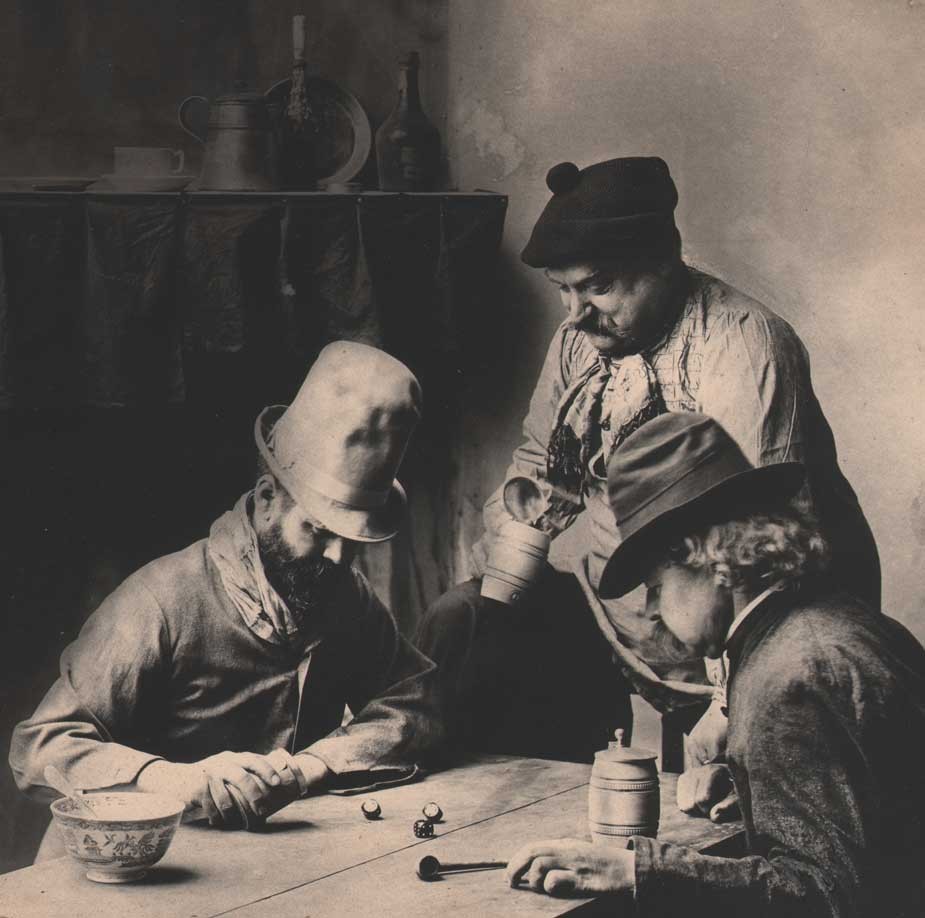 Detail: "The Dice Players": 1891: print ca. 1897 or later: John E. Dumont: carbon print: 29.2 x 25.1 cm (flush mounted to board) : This classic genre photograph by Dumont showing a group of men playing dice (possibly the con game "chuck-a-luck") was first shown in the annual exhibition of the Royal Photographic Society in 1891 and further earned him a gold medal in another contest the same year sponsored by the English journal the Amateur Photographer. From: PhotoSeed Archive
Detail: "The Dice Players": 1891: print ca. 1897 or later: John E. Dumont: carbon print: 29.2 x 25.1 cm (flush mounted to board) : This classic genre photograph by Dumont showing a group of men playing dice (possibly the con game "chuck-a-luck") was first shown in the annual exhibition of the Royal Photographic Society in 1891 and further earned him a gold medal in another contest the same year sponsored by the English journal the Amateur Photographer. From: PhotoSeed Archive
But what immediately followed in the new Eastman Building from April 15-25, 1903: an “Exhibition of Art Craftsmanship”, featuring work from Gustav Stickley’s Craftsman Workshops, (1.) would turn out to be more significant in the overall advancement of the American Arts and Crafts movement compared to the photographic exhibition. A motivating factor perhaps? As it turned out, Harvey Ellis organized the Craftsman show, joining the Stickley firm a month later where he finished a remarkable career.
1. Historical Background: R.I.T. online resource accessed Nov., 2014: “In 1902 the Department of Decorative Arts and Crafts was established at Mechanics Institute under the leadership of Theodore Hanford Pond. An “Exhibition of Art Craftsmanship”, featuring the work of Gustav Stickley’s Craftsman Workshops, was presented in the Mechanics Institute’s Eastman Building, 15-25 April 1903.”
French Revolution Evolution
Posted September 2011 in Engraving, Journals
In France, prior to taking on the complex task of publishing the journal L’Art Photographique, (The Photographic Art) first appearing in July, 1899, Georges Carré and C. Naud in Paris had made a reputation for publishing volumes dealing in scientific, medical, as well as photographic subjects. Their journal the Photo-Gazette under the editorship of Georges Mareschal was the best known.
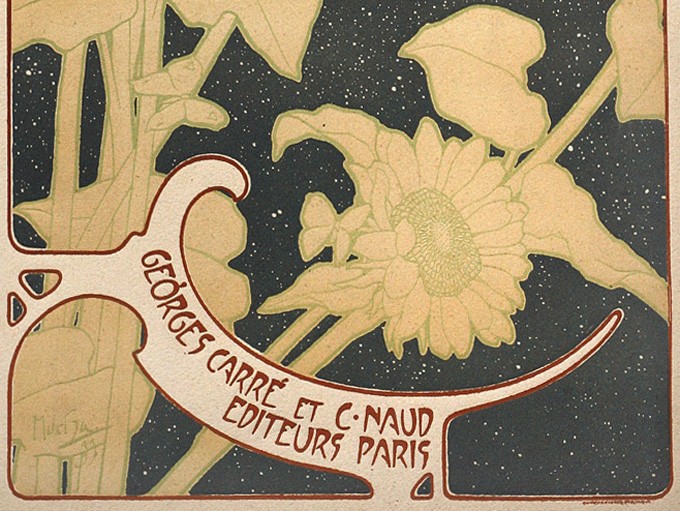 Paris publishers Georges Carré and C. Naud intended to showcase photography on the cover of L'Art Photographique but settled for the tried and true in the form of artwork and typography done by Czech Art Nouveau painter Alphonse Mucha instead.
Paris publishers Georges Carré and C. Naud intended to showcase photography on the cover of L'Art Photographique but settled for the tried and true in the form of artwork and typography done by Czech Art Nouveau painter Alphonse Mucha instead.
With the committed goal of keeping the relevance of photographic art before the public eye and with the backing of France’s elite photographic body in the form of The Photo Club de Paris, Carré and Naud under the leadership of Mareschal set about contracting with multiple printing ateliers throughout the country (1.) in order to showcase work produced by the club’s members.
 Carrying the imprint of Spécimen stamped in blue ink, this plate with the title "Automne" by French photographer Robert Demachy was eventually included with the October, 1899 issue of the journal. Without knowing any specific details, it may have been used as a working production publisher's plate at the outset to publication or even one to solicit potential subscribers for it.
Carrying the imprint of Spécimen stamped in blue ink, this plate with the title "Automne" by French photographer Robert Demachy was eventually included with the October, 1899 issue of the journal. Without knowing any specific details, it may have been used as a working production publisher's plate at the outset to publication or even one to solicit potential subscribers for it.
Certainly with Franz Goerke’s Die Kunst in der Photographie journal in Germany serving as a model beginning only two years earlier in 1897, the publishers believed bigger was better, (46.0 x 34.0 cm) and the task of presenting French work (2.) as reproduction plates in the original size the photographer intended was the stated goal from the outset. Everything about this photographic magazine is admirable, and for France, this evolution would break new ground as the first monthly photographic publication solely devoted to the image itself. Looking back, it is also an important historical record of the cutting-edge, French photographic engraving being produced at this time. The photographic plates included with it are printed in the finest hand-pulled photogravure, collotype, (photocollographie) and single and multiple-color halftone. (similigravure) These in turn are printed, often by a separate atelier, on a variety of French papers running the gamut from hand-made plate paper to traditional examples of thick coated stock. To satisfy the photographic purist, technical details for the images are often supplied on the accompanying plate tissue-guards. So in a word, revolutionary.
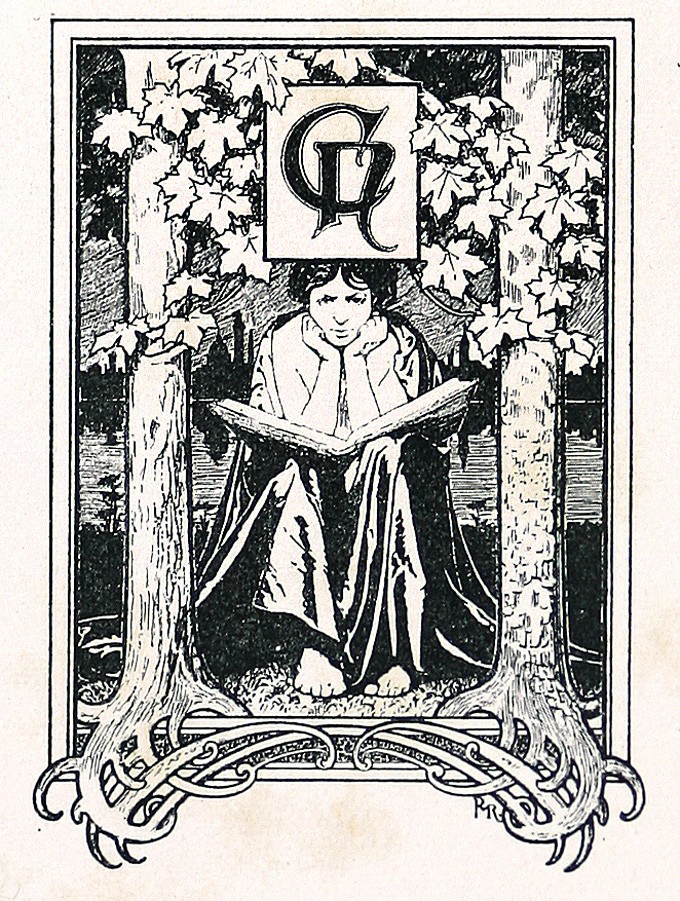 This Art Nouveau, publishers imprint ( 6.5 x 4.7 cm ) woodcut for Georges Carré and C. Naud by the French artist P. Ruty appears on the title page to the bound, collected volume of L'Art Photographique in our archive.
This Art Nouveau, publishers imprint ( 6.5 x 4.7 cm ) woodcut for Georges Carré and C. Naud by the French artist P. Ruty appears on the title page to the bound, collected volume of L'Art Photographique in our archive.
In the mission statement laid out by editor Georges Mareschal in the first issue, he explains the admirable intention of employing the cover itself to showcase a photograph. But because of logistical problems not revealed, (3.) the talents of Czech Art Nouveau painter Alphonse Mucha were employed in 1899 to design its cover used consistently over the one year run ending in June, 1900.
 This detail of a tissue-guard for the plate "Étude a L'Atelier" by Polish photographer Count Aleksander von Tyszkiewicz, (working in Paris) is an example of engraving and technical specifics for work included in the journal. It was included in the September, 1899 issue.
This detail of a tissue-guard for the plate "Étude a L'Atelier" by Polish photographer Count Aleksander von Tyszkiewicz, (working in Paris) is an example of engraving and technical specifics for work included in the journal. It was included in the September, 1899 issue.
At PhotoSeed, we are excited to be able to present all 48 photographs from L’Art Photographique in their order of publication beginning here.
Notes:
1. Nine in France and the long established firm of Jean Malveaux in Brussels.
2. Although several examples from Argentina, Belgium, England and a Polish photographer working in Paris are included.
3. My own conjecture on this surmises the publishers felt an over-sized magazine needed to be “shown off” better-especially with the resources being devoted to its production, and there was certainly no better way to do this than to employ a cover “poster effect” in the form of a full-color lithograph by Mucha.